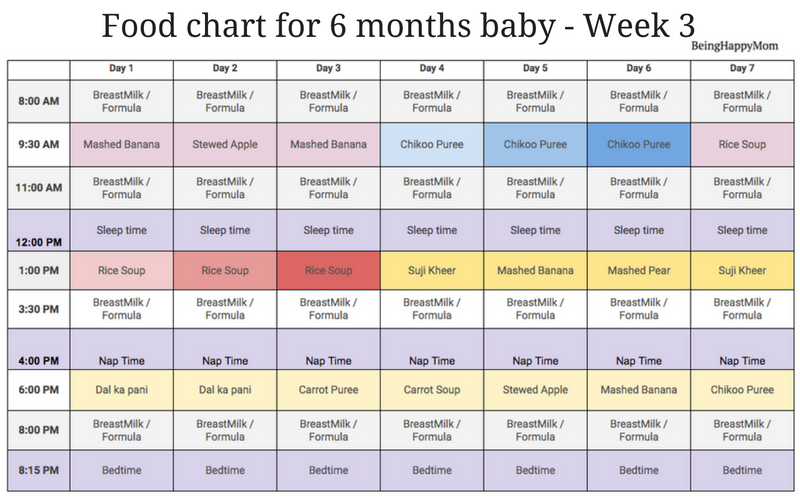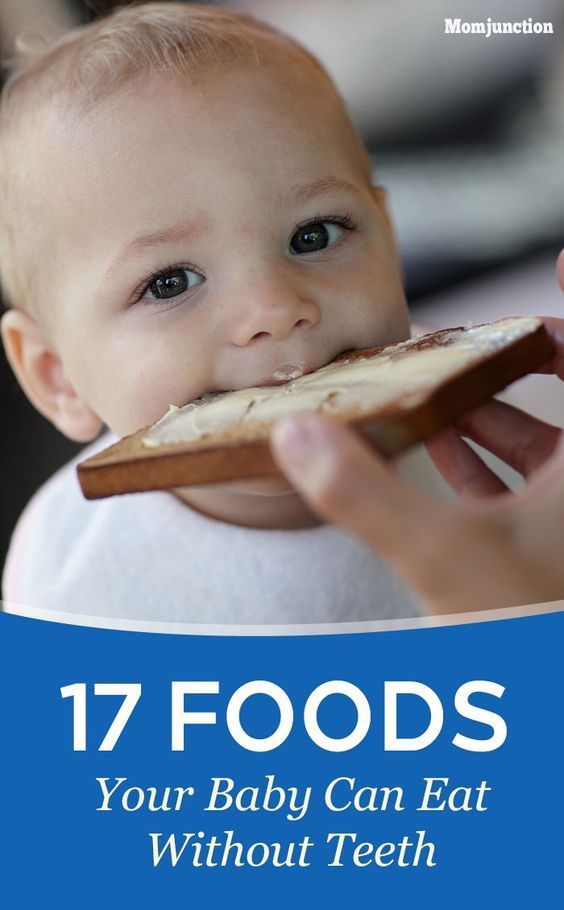How to feed baby bread
When to Introduce, Types, Baby-Led Weaning
“Our daily bread.” “Let’s break bread.” “The best thing since sliced bread.” Ever notice how many idioms revolve around bread?
In Western culture, this simple loaf of wheat or other grains has been a dietary staple for centuries. In fact, historians believe bread has been around since the ancient Egyptian era.
If you have an infant, you may be wondering when your child should continue the centuries-long trend of bread consumption.
Or perhaps you’ve wondered whether they should eat bread at all. With the rise of low carb and gluten- or grain-free diets, bread has certainly taken a hit in popularity in recent years.
For the record, bread is generally safe and healthy for babies to eat. Here’s what you need to know about when and how to feed it to your little one.
As a parent to your precious kiddo, you likely have safety top of mind at pretty much all times. (So many choking hazards! So many things to childproof!)
Food is one of the many areas where safety matters.
When feeding your baby bread, you’ll want to be aware of a few factors. First — and this is kind of counterintuitive — it’s actually the softer, chewier breads that can sometimes pose more problems for little eaters.
Breads with a softer consistency, like white sandwich bread, have a tendency to gum up into an un-swallowable ball in a baby’s mouth. This can lead to gagging or choking — or a spit-out pile of soggy bread gloop on the high chair tray.
To help a soft bread go down easier, try toasting it. This will remove some of its moisture so it’s less likely to stick together in baby’s mouth.
On the other side of the bread spectrum, a hard, crusty bread can be difficult for babies who have very few teeth to gnaw through it with.
Though you might try offering a bread crust to your child so they can experience its texture, they may not get very far on actually consuming it, depending on their chewing skills.
For this reason, crusty breads are best for older babies with more chewing experience.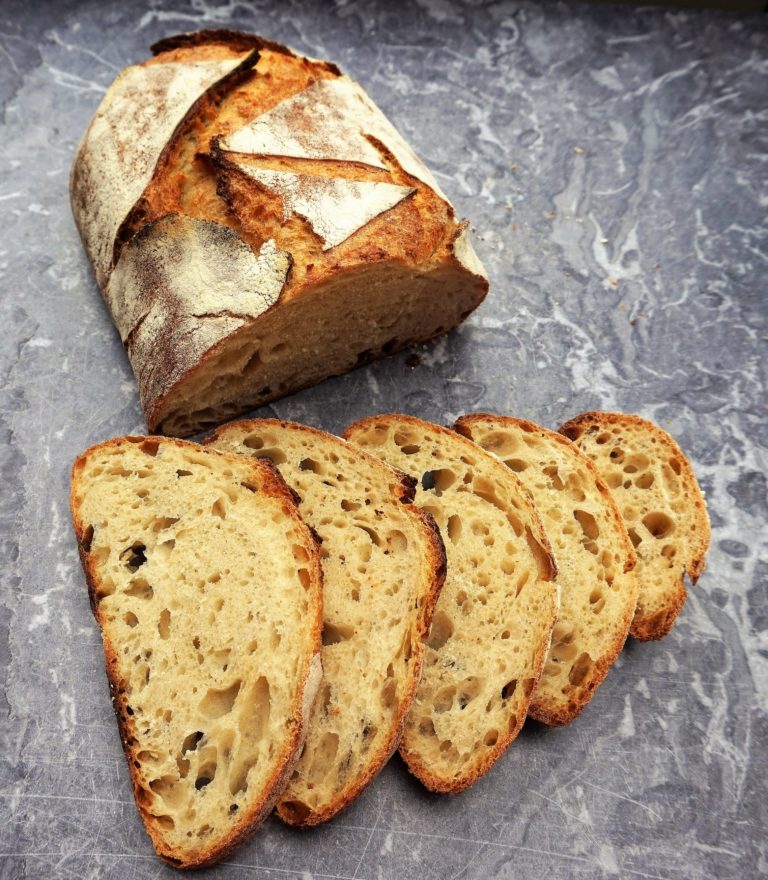 For babies just starting out with solids, stick to breads with middle-of-the-road density to minimize the risk of choking.
For babies just starting out with solids, stick to breads with middle-of-the-road density to minimize the risk of choking.
There’s no perfect schedule for when to introduce bread or toast to your baby.
The Academy of Pediatrics (AAP) gives the go-ahead for starting a variety of solid foods from around 6 months old — and bread can be included from this age.
When you do decide to debut a bit of sourdough or ciabatta, just be sure it’s not accompanied by other foods new to your child.
The Centers for Disease Control and Prevention (CDC) recommends introducing just one food at a time to your baby, waiting 3 to 5 days between new menu items.
If your child happens to have a negative reaction to something they ate, this allows you to identify the culprit more easily.
Baby-led weaning involves offering small pieces of food to your child, allowing them to feed themselves rather than be spoon-fed. As your kiddo approaches older babyhood, this approach can help them transition to table foods with more confidence and independence.
Baby-led weaning is associated with a number of benefits, like promoting more nutritious eating later in life and helping kids maintain a healthy weight.
Bread makes a super easy go-to when starting out with baby-led weaning.
Simply cut or tear a slice of bread into bite-size pieces, place them on the high chair, and let your child pincer-grasp them to their mouth. (Again, to make bread less gummy, toast it first.)
As always, with bread or any other foods your child self-feeds, stay close by as they eat so you can monitor for signs of choking.
100 percent whole wheat bread
Looks can be deceiving. Sometimes breads that use the words “whole wheat” in their name are not, in fact, made with just whole wheat flour.
To be sure you’re getting the whole high-fiber package for your baby, choose breads that explicitly state they’re made with 100 percent whole wheat or other whole grains.
Our pick: Whole Foods Organic Whole Wheat Sandwich Bread
Sprouted grain bread
For extra fiber and nutrients in your child’s diet, check out sprouted grain bread.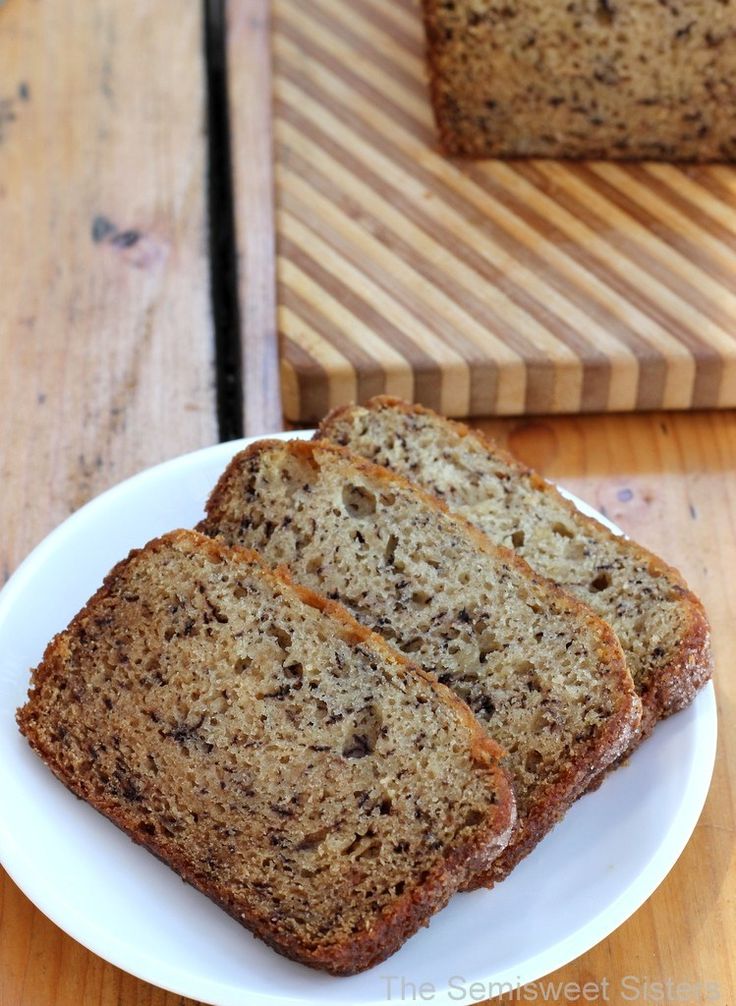
These loaves may contain a wide variety of grains harvested at the point of sprouting. Grains might include millet, spelt, kamut, or barley.
Many brands also include high-fiber, high-protein legumes like lentils and soy beans.
Our picks: Food for Life Ezekiel 4:9 Sprouted Grain Bread and Simple Truth Organic Sprouted Grain and Legume Bread
Sourdough or other hearty white
Soft white breads may turn gummy in baby’s mouth, but the texture of sturdier options like sourdough or rustic white bread will hold up far better.
Our pick: Dave’s Killer Bread White Bread Done Right
Breads with nuts and seeds
Tasty and nutritious though nuts and seeds may be in bread, they’ll have to wait until baby is a bit older.
Loaves that contain large chunks of nuts or have sunflower seeds studded around their exterior, for example, pose a choking hazard for very young children.
Breads with honey or lots of added sugar
The advice that goes for grown-ups goes for babies, too: Keep added sugar to a minimum.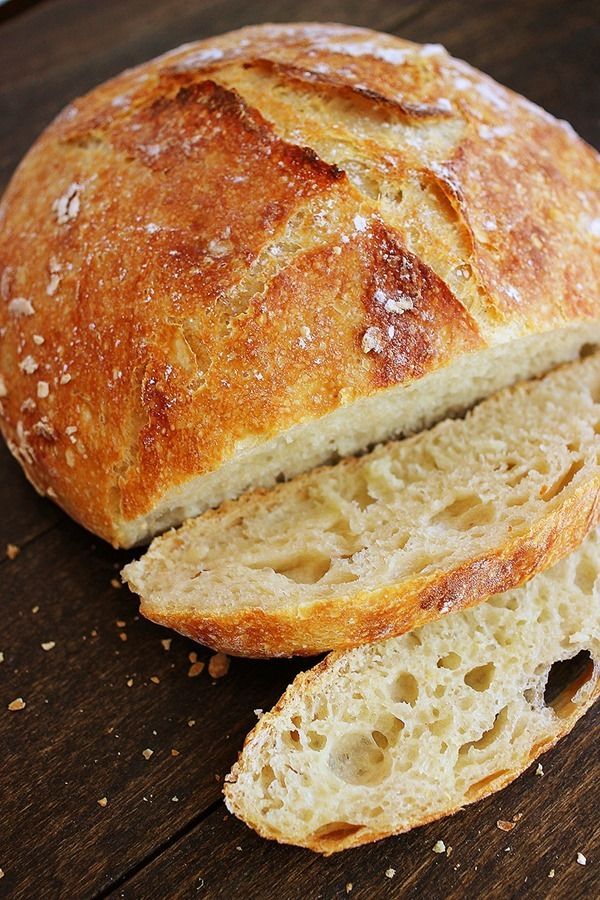 (Yep, it’s basically always a good idea for health.)
(Yep, it’s basically always a good idea for health.)
Look for breads with no added sugars in their ingredient list. This may require a bit of label-reading savvy — many sweeteners go by names you might not recognize.
That said, if learning all the names of sugar is too overwhelming, seek out breads with 2 grams or fewer of sugar per slice.
Another important point: Even in baked goods, honey is a no-no for babies under 1 year old. If honey shows up on a bread’s ingredient list, leave it on the shelf.
Breads with high sodium
Babies’ developing bodies don’t need that much sodium — and too much of this mineral can actually harm their kidneys. But bread is among the sneakiest sources of sodium in our diets, according to the American Heart Association.
Keep up your label reading by looking for breads with lower sodium, such as 100 milligrams or fewer per serving.
We’re willing to bet you’re familiar with the fact that bread contains wheat (at least, usually).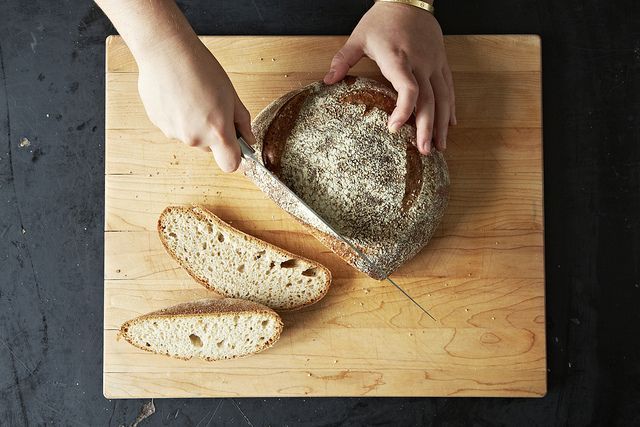
Wheat is among the top eight food allergens responsible for 90 percent of all dietary allergies. If wheat or other food allergies run in your family, you may feel hesitant about introducing your child to bread.
However, according to the AAP, there’s no medical reason to delay the introduction of potentially allergenic foods, even with a family history of allergies.
When budget and time allow, it’s also smart to offer your child breads made from a wide variety of grains. This can set them up for enjoying a broad range of flavors and textures.
And, on a positive note, don’t forget that 100 percent whole wheat bread (and many other varieties) are rich in fiber, which can improve infants’ digestion. When baby is struggling with constipation, incorporate fiber-rich bread alongside other high-fiber choices.
Since bread is a mild, palatable food, it doesn’t take a lot of creativity to prepare bread in a way your baby is likely to enjoy. A cut-up slice of toast with a thin schmear of butter is a simple, yummy snack that doesn’t need any extra flair.
Bread can also serve as the base for innumerable interesting, baby-pleasing recipes.
For a breakfast rich in protein and complex carbohydrates, spread a bit of peanut butter on toast (if you’ve already successfully introduced peanuts), then top with mashed or sliced banana.
Or start your mini hipster early on the avo toast trend by serving a tablespoon of mashed avocado on whole wheat.
At lunch or dinnertime, try topping toast with savory mashed sweet potatoes dusted with cinnamon or a layer of smashed chickpeas with fresh dill.
To make sandwiches and toast even more appealing to toddlers, use cookie cutters to cut them into fun shapes.
From an early age, it’s totally fine to feed babies bread made from a variety of grains.
With endless prep options at breakfast, lunch, or dinner, “daily bread” can quickly become a reality for your child.
Can Babies Eat Bread? - Which is the Best Bread for Babies
When can babies eat bread?
Bread may be introduced as soon as a baby is ready to start solids, which is generally around 6 months of age. Note: Bread often contains common allergens like dairy, egg, sesame, soy, tree nut, and wheat so introduce with care.
Note: Bread often contains common allergens like dairy, egg, sesame, soy, tree nut, and wheat so introduce with care.
Baby just starting solids? Our guides have got you covered, from introducing allergens to breakfast ideas.
Background and origins of bread
Bread is the most widely consumed food in the world. For thousands of years, humans have been baking bread by grinding plants into meal, mixing flour with water, and exposing dough to heat. The sprawling family tree of bread likely began with flatbread—a simple flour-and-water dough cooked quickly on a hot surface. Fast-forward from that humble beginning to today: every day, bakers produce hundreds of styles of savory and sweet bread across the world, from Afghani bolani to Belgian waffle to Chinese laobing to Indian papadum to Jamaican bammy to Mexican pan dulce to Nepali sel roti. Some breads like French croissants and Philippine pandesal are leavened with yeast, which puffs the dough as the bacteria consumes sugars in the flour.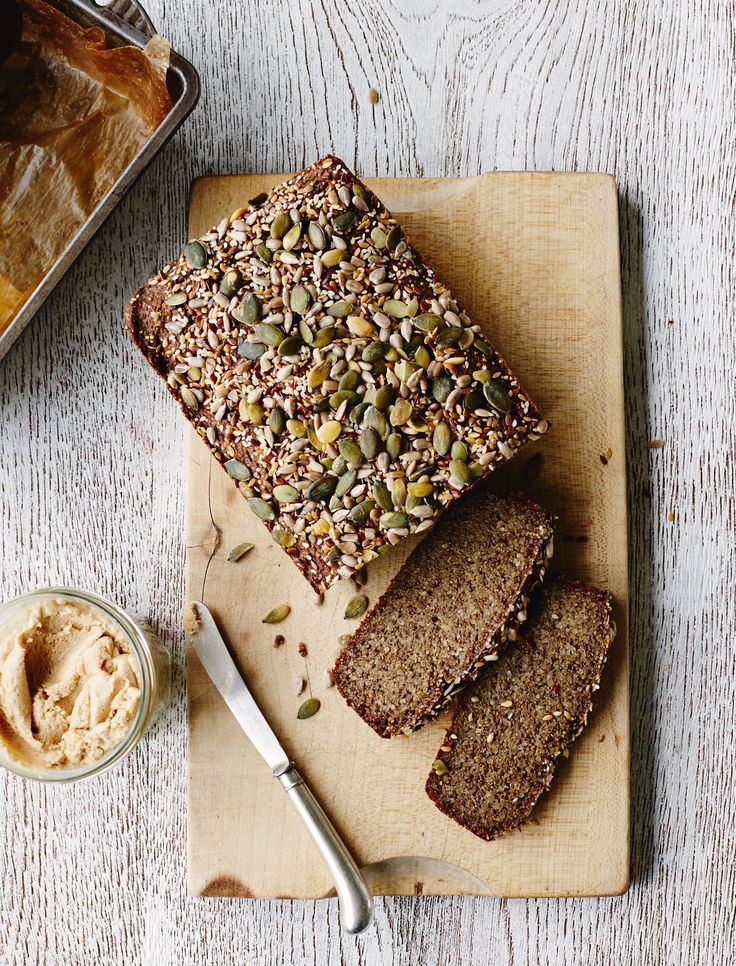 Other breads omit leavening agents, such as lavash, matzo, roti, and tortilla. The type of flour used to bake bread varies widely, too. Wheat is the world’s most common bread grain, but some bakers choose flours made of barley, corn, millet, oats, sorghum, rice, and rye. Others bake gluten-free breads with flours made of legumes, nuts, and root vegetables like cassava or yuca, the key ingredient in Taino flatbread called casabe.
Other breads omit leavening agents, such as lavash, matzo, roti, and tortilla. The type of flour used to bake bread varies widely, too. Wheat is the world’s most common bread grain, but some bakers choose flours made of barley, corn, millet, oats, sorghum, rice, and rye. Others bake gluten-free breads with flours made of legumes, nuts, and root vegetables like cassava or yuca, the key ingredient in Taino flatbread called casabe.
What type of bread would you like to serve to a baby? Bread is deeply personal and connected to culture, family, history, and religion. Whether you want to serve your favorite or explore a new-to-you bread, let’s dive into how to introduce this beloved staple food.
Is bread healthy for babies?
Yes—when consumed as part of a balanced diet.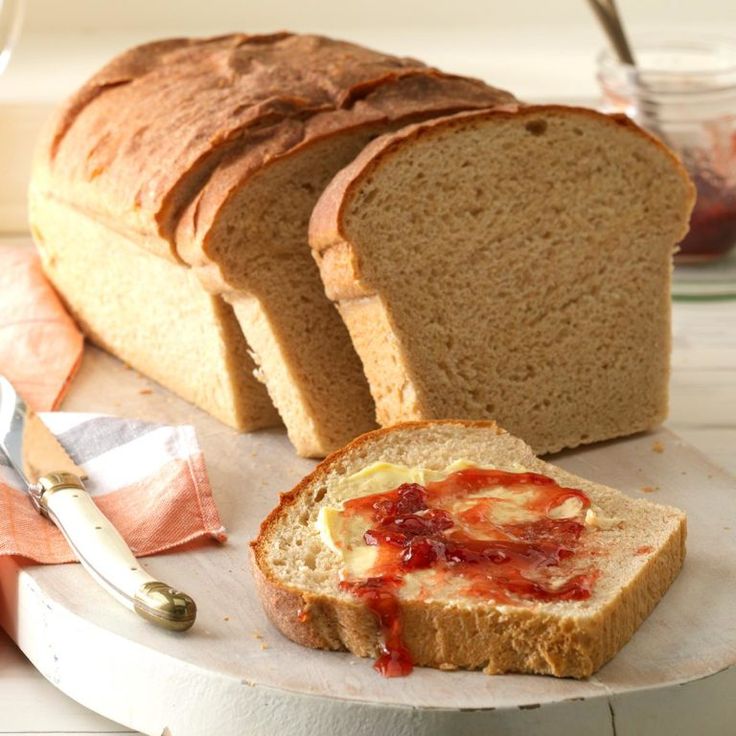 All bread offers plenty of carbohydrates plus some fiber and protein, too. However, nutrition varies widely depending on the type of bread, with some offering more nutrients than others.
All bread offers plenty of carbohydrates plus some fiber and protein, too. However, nutrition varies widely depending on the type of bread, with some offering more nutrients than others.
Among the most nutritious breads are those made from fermented or sprouted grains. Sprouted grains have begun the germination process, meaning that the seeds have started to sprout from exposure to water and warm temperatures. This process can make the grains easier for the human body to digest and absorb nutrients.1 And often breads made with fermented and sprouted grains offer more nutrients than breads made with whole grains.
Breads made entirely of whole grain are also an excellent choice for babies as they offer much more fiber, protein, and nutrients than breads made of refined flour. When you want to give baby an extra boost of nutrition, choose breads labeled “100% whole grain” over those labeled “whole wheat” or “whole grain”, which are misleading terms as these breads often contain a mixture of whole grain flour and refined flour, which offers less nutrition than 100% whole grain.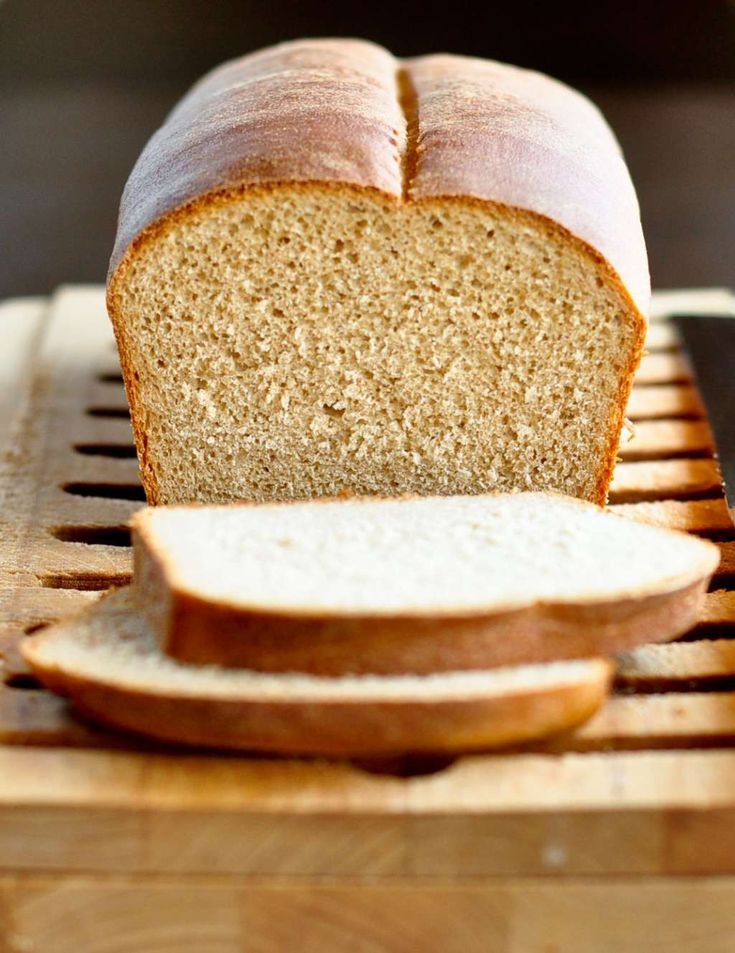 2 3
2 3
★Tip: When shopping for bread, read the ingredient list closely. Some breads contain common allergens such as dairy, egg, sesame, soy, and tree nuts and many have added sodium and sweeteners. When you can, opt for bread made with fortified or enriched flour with less than 100 milligrams of sodium per serving and no added sugar. Learn more about navigating sodium and sugar in a baby’s diet.
Which breads are most nutritious for babies?
In our professional opinion, it’s hard to beat breads made with fermented grains or sprouted grains. These breads offer so much more nutrition than breads made with refined grains that are stripped of the nutrient-rich parts of the seed kernels.
Breads made of sprouted grains (brands like Angelic, Dave’s Killer Bread, Ezekiel Bread by Foods for Life, and Silver Hills) are packed with protein and fiber. They also offer lots of B-vitamins and minerals like iron and selenium. Sometimes sprouted grain breads even contain legumes like lentils, mung beans, or soybeans, which offer an extra nutritional boost.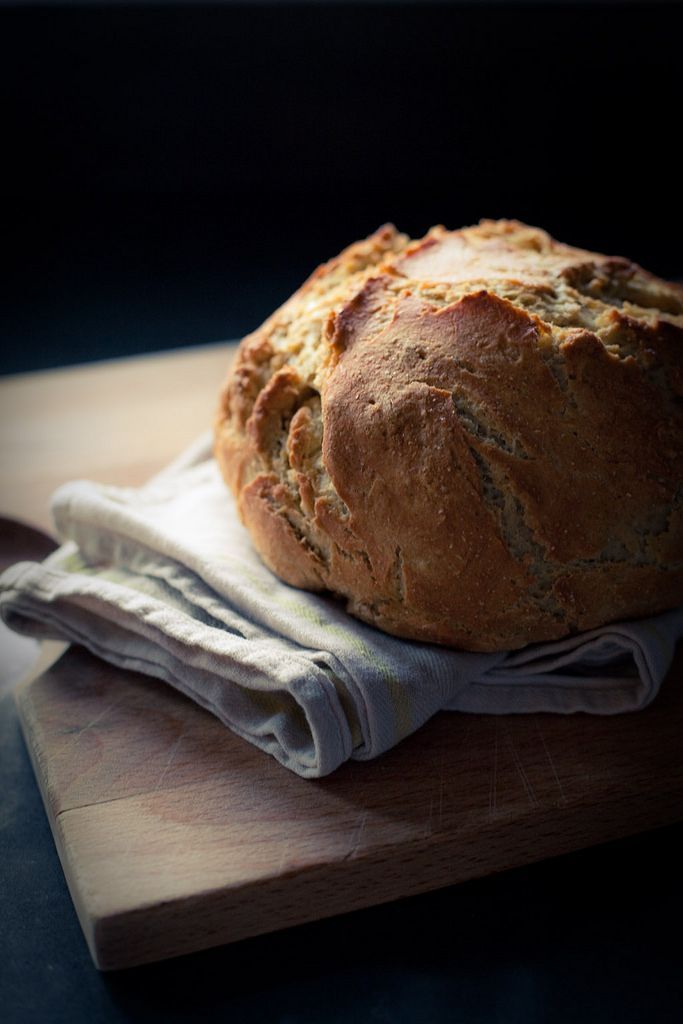 Just be sure to watch out for whole seeds and nuts that may be added.
Just be sure to watch out for whole seeds and nuts that may be added.
Bread made from traditional lactic acid fermentation (such as broa, injera, kisra, and sourdough) are also an excellent choice as they contain beneficial bacteria that help babies build a healthy gut.4 Nutrition varies based on the ingredients and style of baking, yet studies have found that generally fermented breads are easier to digest than breads made with dry yeast, plus their nutrients are more easily absorbed by the human body.5
★Tip: Choose breads made of organic wheat when budget and access allow for it—or opt for breads made of alternative grains, such as like amaranth, buckwheat, emmer, Khorasan wheat, quinoa, or spelt. Breads made with conventionally-grown wheat that is heavily sprayed with pesticides can negatively impact human and environmental health.6 7
When can babies have bagels?
Bagels may be introduced as soon as baby is ready for solids, around 6 months of age as long as it is free of honey.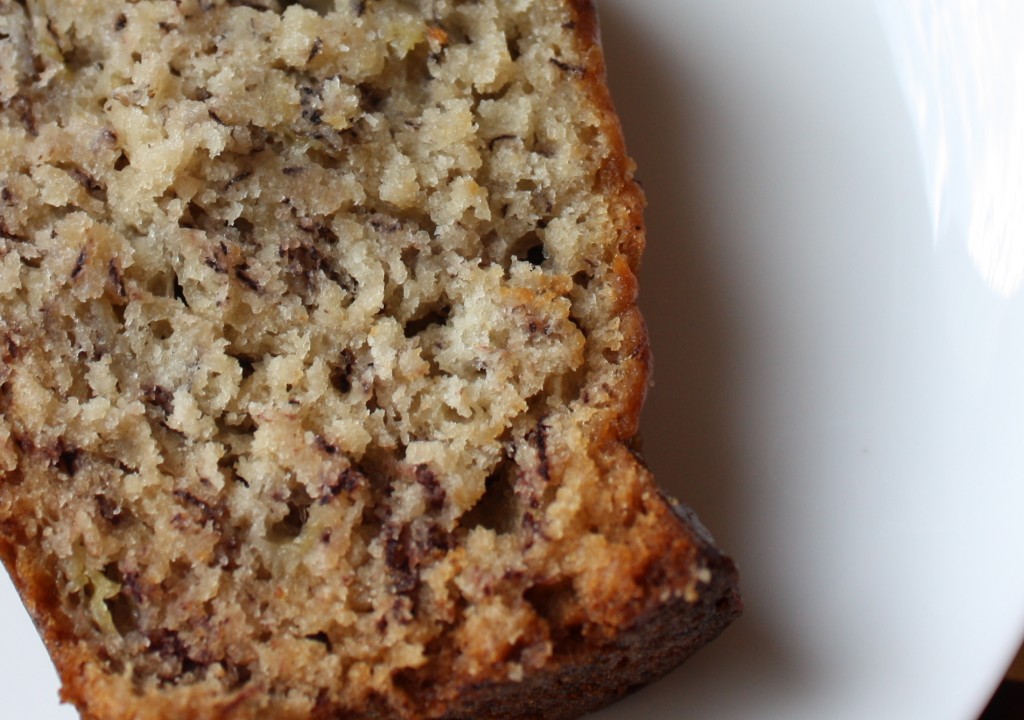 While babies are unlikely to consume much of the bagel, the chewy, resistive texture is great for developing baby’s biting and tearing skills along with overall jaw strength. Note that bagels can contain several allergens (eggs, sesame, dairy) so read labels carefully. Avoid “salt”-variety bagels and opt for spreads that are naturally low in sodium such as labneh cheese, mascarpone, ricotta cheese, or unsalted butter.
While babies are unlikely to consume much of the bagel, the chewy, resistive texture is great for developing baby’s biting and tearing skills along with overall jaw strength. Note that bagels can contain several allergens (eggs, sesame, dairy) so read labels carefully. Avoid “salt”-variety bagels and opt for spreads that are naturally low in sodium such as labneh cheese, mascarpone, ricotta cheese, or unsalted butter.
When can babies have flatbreads?
You can offer baby flatbreads (the soft kind, not crackers) around 6 months of age, although toasting them can help prevent the bread from gumming up in baby’s mouth. You can also roll up a piece of flatbread into a stick shape, to make it easier for baby to hold. When baby’s pincer grasp develops, closer to 9 months, you can offer bite-size pieces of flatbread. Flatbreads are popular across the globe: arepa, focaccia, frybread, lavash, lefse, pita, and roti, to name just a few. These varieties are made with different ingredients and different methods, which means that they may or may not contain common allergens. Read the labels when purchasing store-bought flatbreads for allergen information, and try to choose brands with lower levels of sodium when serving to baby.
Read the labels when purchasing store-bought flatbreads for allergen information, and try to choose brands with lower levels of sodium when serving to baby.
How much bread can babies and toddlers have in a day?
Bread is considered a grain food and, similar to dairy products, recommendations for grain foods are given in servings per day and will vary by age and a child’s individual needs. One serving of a grain food for a child is generally given in 1-ounce (~28 g) equivalents (but please, don’t measure this out, it is fine to eyeball) and looks like: 1 regular slice of bread, 1 mini bagel or about ¼ of a large bagel, 1 small corn tortilla, ½ cup of cooked grains (like rice, bulgur, barley, or oats) or cooked pasta, or around 1 cup of dry cereal. While all of these foods don’t technically weigh 1 ounce, they are all considered 1 serving of grain foods.8 9 10
When it comes to amounts recommended by age, remember that the goal here is just to make sure the child doesn’t overly fill up on bread and grains and not have space for other foods, like proteins, fruits, and vegetables. Any child may eat more or less than what’s recommended, depending on their appetite, age, and general needs, and that is totally normal and okay! Remember, as the adult, it’s your job to decide which types of food to offer and when, but it’s up to the child to decide how much they eat.
Any child may eat more or less than what’s recommended, depending on their appetite, age, and general needs, and that is totally normal and okay! Remember, as the adult, it’s your job to decide which types of food to offer and when, but it’s up to the child to decide how much they eat.
Grain servings by age:
6 to 12 months old: No set recommendations. Time to explore and gradually learn how to eat grain foods! Opt for whole grains where you can, but don’t sweat it if that’s not always possible.
12 to 23 months: Total of 1.75-3-ounce equivalents daily, which could look like ~2-3 slices of bread OR about ~1-1.5 cups of cooked grains or pasta daily. Over the course of 1 day, this could look like 1 small wheat roti, ¼ cup of cooked bulgur, and ½ cup of cooked oatmeal.
24 to 36 months: Total of 3-5-ounce equivalents daily. This could look like ~3-5 slices of bread OR about ~1.5-2.5 cups of cooked grains or pasta daily.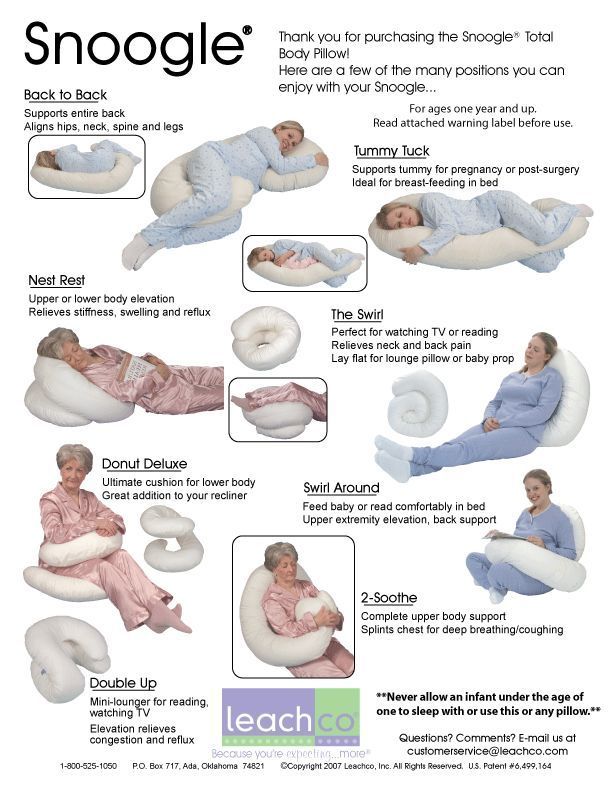 Over the course of 1 day, this could look like 1 small corn tortilla, ½ cup of cooked bulgur, ½ cup of cooked oatmeal, and 1 cup of dry cereal.
Over the course of 1 day, this could look like 1 small corn tortilla, ½ cup of cooked bulgur, ½ cup of cooked oatmeal, and 1 cup of dry cereal.
Is bread a common allergen?
Yes. Bread often contains common allergens like milk, egg, sesame, soy, tree nut, and wheat. Read labels closely and wait to introduce breads until all common allergens on the ingredient list have been safely introduced.
Wheat is one of the most common food allergens in children.11 Fortunately, two-thirds of children outgrow the allergy by their 12th birthday.12 Individuals with Oral Allergy Syndrome (also known as pollen food allergy syndrome) may be sensitive to wheat, particularly those who are allergic to grass pollen. Oral Allergy Syndrome typically results in short-lived itching in the mouth. It is unlikely to result in a dangerous reaction.13
While rare, some individuals have a condition known as wheat-dependent, exercise-induced anaphylaxis, which can result in a severe allergic reaction if the person exercises within a few hours after eating wheat.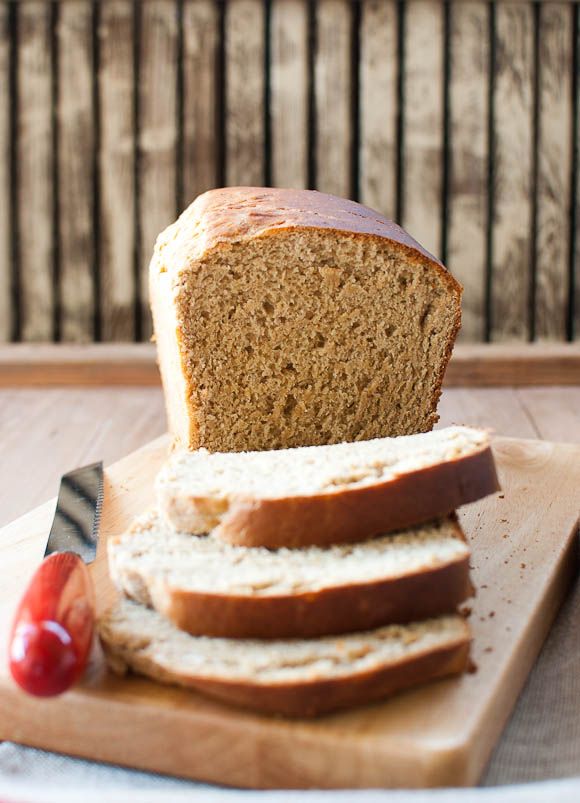 These patients should avoid eating wheat in the four hours before strenuous activity.14
These patients should avoid eating wheat in the four hours before strenuous activity.14
It is important to note that wheat allergy is not the same as celiac disease. While a wheat allergy may be outgrown, celiac disease requires a strict, lifelong gluten-free diet and lifestyle.15 A gluten “allergy” is typically a misnomer, often in reference to celiac disease.16
If your baby has a family history of allergies or you suspect your baby is allergic to wheat, talk to a pediatric health care provider before introducing bread at home. As you would when introducing any new food, start by offering a small quantity for the first couple of servings and watch closely for any signs of an allergic reaction. If there is no adverse reaction, gradually increase the amount over future servings.
Recommended Guide: Introducing Allergens to Babies
Can babies eat gluten?
Yes—as long as a child does not have wheat allergy, non-celiac gluten sensitivity, or celiac disease. Gluten is simply a type of protein in wheat and other grains such as barley, rye, and some oats. Gluten is edible, but it becomes problematic for individuals with celiac disease, an autoimmune disease, characterized by damage of the small intestine when gluten is consumed.17 18 19 Some individuals may be sensitive to gluten but may not have an allergy or celiac disease. In some cases, this may be non-celiac gluten sensitivity. However, gluten-containing grains can also contain certain carbohydrates that are difficult for some individuals to digest.
Gluten is simply a type of protein in wheat and other grains such as barley, rye, and some oats. Gluten is edible, but it becomes problematic for individuals with celiac disease, an autoimmune disease, characterized by damage of the small intestine when gluten is consumed.17 18 19 Some individuals may be sensitive to gluten but may not have an allergy or celiac disease. In some cases, this may be non-celiac gluten sensitivity. However, gluten-containing grains can also contain certain carbohydrates that are difficult for some individuals to digest.
Talk to a health care provider if you are concerned about issues related to gluten and digestion.
Is bread a common choking hazard for babies?
It can be. Bread can be tricky for babies as can soften and stick together, forming a large mass in the mouth that can cling to the tongue and roof of mouth. To minimize the risk, toast bread before serving to young babies and consider adding a thin layer of a smooth spread mashed avocado, fresh ricotta cheese, hummus, labneh, or yogurt to aid swallowing.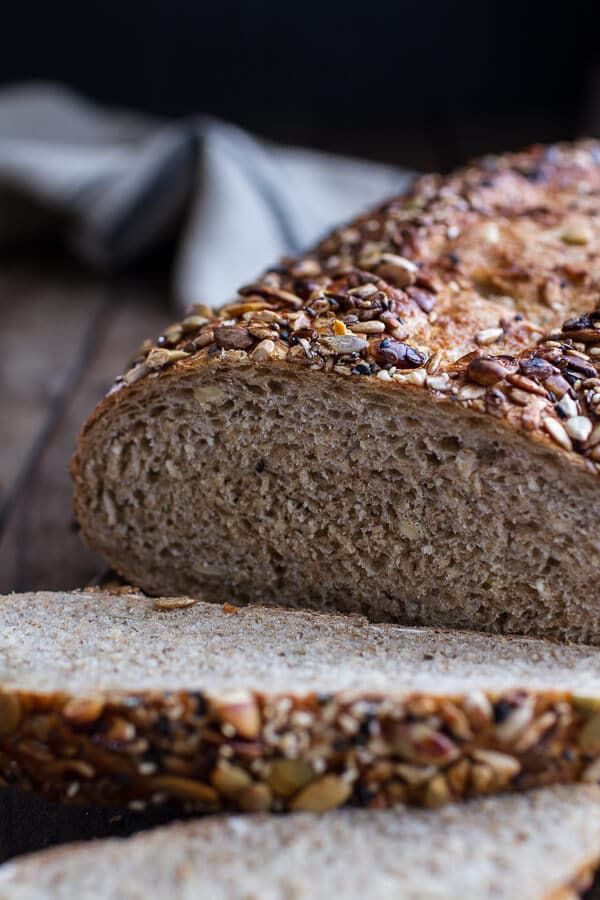
As always, make sure to create a safe eating environment, to stay within an arm’s reach of a baby during mealtime, and check out our age-appropriate serving suggestions.
For more information, visit our section on gagging and choking and familiarize yourself with common choking hazards.
How do you cut bread for babies with baby-led weaning?
Every baby develops on their own timeline, and the suggestions on how to cut or prepare particular foods are generalizations for a broad audience. Your child is an individual and may have needs or considerations beyond generally accepted practices. In determining the recommendations for size and shape of foods, we use the best available scientific information regarding gross, fine, and oral motor development to minimize choking risk. The preparation suggestions we offer are for informational purposes only and are not a substitute for child-specific, one-on-one advice from your pediatric medical or health professional or provider. It is impossible to fully eliminate all risk of a baby or child choking on any liquid, puree, or food. We advise you to follow all safety protocols we suggest to create a safe eating environment and to make educated choices for your child regarding their specific needs. Never disregard professional medical advice or delay in seeking it because of something you have read or seen here.
It is impossible to fully eliminate all risk of a baby or child choking on any liquid, puree, or food. We advise you to follow all safety protocols we suggest to create a safe eating environment and to make educated choices for your child regarding their specific needs. Never disregard professional medical advice or delay in seeking it because of something you have read or seen here.
6 to 9 months old: Large ends of thick, crusty bread and strips of toast about the size of two adult fingers held together can be safer than thin pieces of soft sliced bread, which can clump and stick together in the mouth. Look for bread pieces that have some resistance to them and if any piece is making you nervous, simply remove it from your baby’s eating area and replace it with something else. Refrain from offering bread with sticky nut butter on it to minimize the choking risk.
9 to 12 months old: At this age, babies develop a pincer grasp (where the thumb and pointer finger meet), which enables them to pick up smaller pieces of food.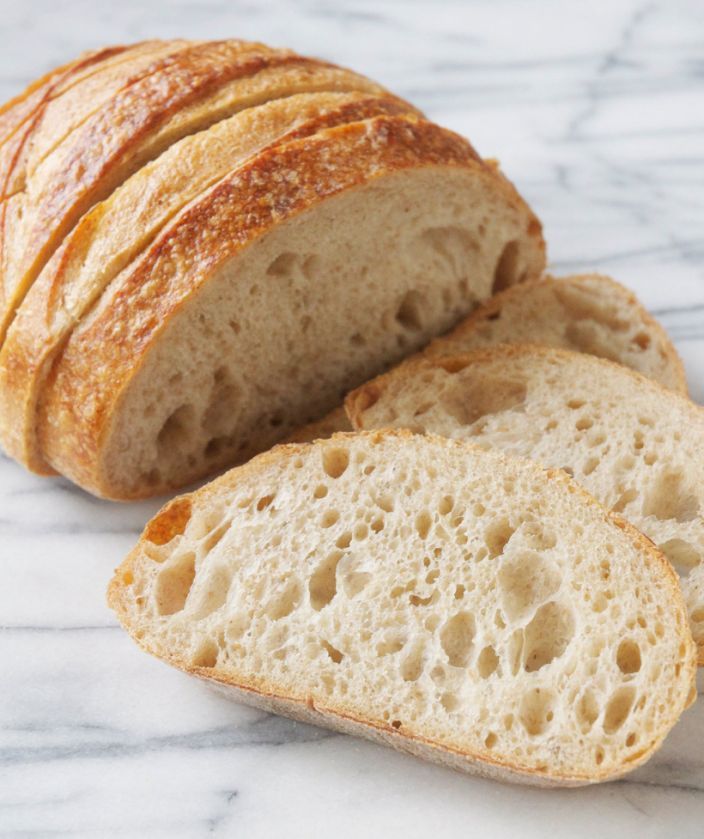 As such, this is a great time to move down in size to thin matchstick strips of toast or small, bite-sized pieces of bread. If baby is shoveling many pieces of bread or stuffing whole strips of bread in at once, offer more resistive breads like the crusty end, and model how to take bites, to tear pieces off with your teeth, and to chew well.
As such, this is a great time to move down in size to thin matchstick strips of toast or small, bite-sized pieces of bread. If baby is shoveling many pieces of bread or stuffing whole strips of bread in at once, offer more resistive breads like the crusty end, and model how to take bites, to tear pieces off with your teeth, and to chew well.
12 to 18 months old: Go time! This is a great age to explore a wide variety of breads and to offer slices for biting, tearing, and chewing practice. Offer large pieces of sliced bread cut in half or quarters. As your toddler’s chewing skills improve, you can expect less gagging, but any moist, sticky bread may still cause some gagging even at this age. If a child is routinely taking too-big bites of bread, with go bigger and more resistant in size, or offer less bite-size pieces at a time.
18 to 24 months old: Sandwich time! Babies like to take apart a sandwich to explore what’s inside and eat the pieces separately. Around the 18- to 24-month-mark, toddlers learn how to keep the sandwich together, which unlocks a world of possibilities at mealtime. Avoid deli meats (which are packed with sodium and nitrates) and jams or jellies (which are packed with sugar). If mixed consistencies (foods with more than one texture) are new for your toddler, supervise your child closely the first few times a sandwich is offered as they will be figuring out how to manage the different textures in one bite.
Around the 18- to 24-month-mark, toddlers learn how to keep the sandwich together, which unlocks a world of possibilities at mealtime. Avoid deli meats (which are packed with sodium and nitrates) and jams or jellies (which are packed with sugar). If mixed consistencies (foods with more than one texture) are new for your toddler, supervise your child closely the first few times a sandwich is offered as they will be figuring out how to manage the different textures in one bite.
How often should you offer solids? See our sample feeding schedules for babies of every age.
Recipe: Fresh Lemony Cheese on Toast
Yield: 1 slice
Time: 5 minutes
Age: 6 months+
Ingredients
- 1 slice sprouted grain bread, sourdough, or bread of choice
- 1 tablespoon fresh ricotta cheese, mascarpone cheese, labneh, or quark
- ¼ teaspoon lemon zest
- ¼ teaspoon sesame seed (optional)
Directions
- Lightly toast the bread.

- Mix the cheese and lemon zest.
- Thinly spread the lemony cheese on the toast. Sprinkle sesame seeds on top.
- Cut the toast into strips for babies between 6 and 12 months of age or keep whole for toddlers.
To Serve: Lay the toast in front of baby. Let your child self-feed if they can. If baby needs help, pass the toast in the air for baby to grab from you.
This recipe contains common allergens: dairy, sesame, and wheat. Only serve to your child after each of these individual allergens have been introduced safely.
Flavor Pairings
Bread pairs with sweet and savory foods alike. Try experimenting with different flavor combinations that suite your family’s preferences and tastes.
Reviewed by
J. Truppi, MSN, CNS
V. Kalami, MNSP, RD
K. Grenawitzke, OTD, OTR/L, SCFES, IBCLC, CNT
S. Bajowala, MD, FAAAAI. (allergy section)
R. Ruiz, MD Board-Certified General Pediatrician and Pediatric Gastroenterologist
- Benincasa, P.
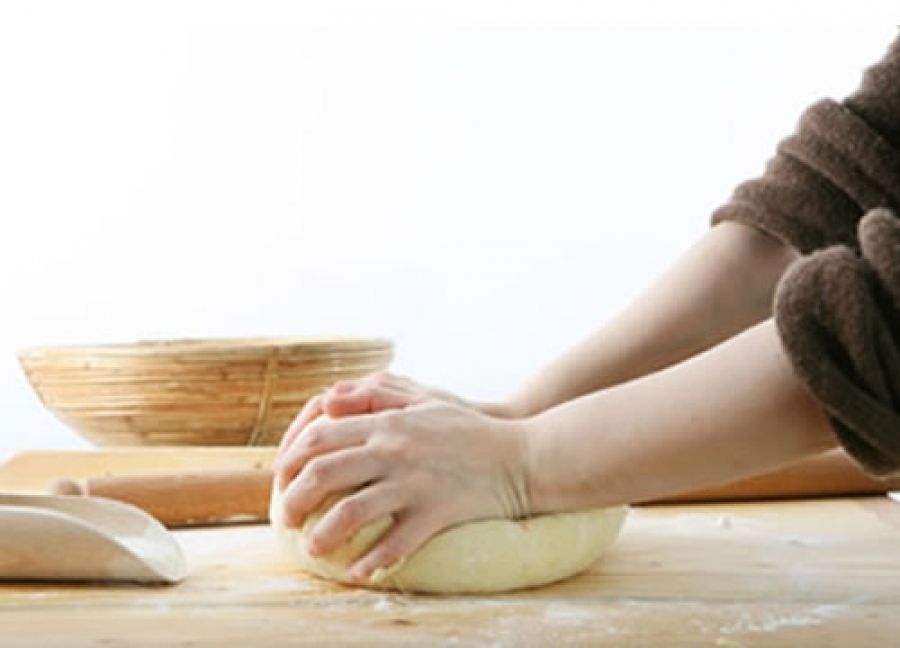 , Falcinelli, B., Lutts, S., Stagnari, F., & Galieni, A. (2019). Sprouted Grains: A Comprehensive Review. Nutrients, 11(2), 421. DOI:10.3390/nu11020421. Retrieved February 19, 2021
, Falcinelli, B., Lutts, S., Stagnari, F., & Galieni, A. (2019). Sprouted Grains: A Comprehensive Review. Nutrients, 11(2), 421. DOI:10.3390/nu11020421. Retrieved February 19, 2021 - United States Food & Drug Administration. (2006). Draft Guidance for Industry and FDA Staff: Whole Grain Label Statements. Retrieved February 19, 2021
- United States Department of Agriculture: Food Safety and Inspection Unit. (2017). Food Safety and Inspection Service Guideline on Whole Grain Statements on the Labeling of Meat and Poultry Products. Retrieved February 19, 2021
- Petrova, P., Petrov, K. (2020). Lactic Acid Fermentation of Cereals and Pseudocereals: Ancient Nutritional Biotechnologies with Modern Applications. Nutrients, 12(4), 1118. DOI:10.3390/nu12041118. Retrieved February 19, 2021
- Petrova, P., & Petrov, K. (2020). Lactic Acid Fermentation of Cereals and Pseudocereals: Ancient Nutritional Biotechnologies with Modern Applications. Nutrients, 12(4), 1118.
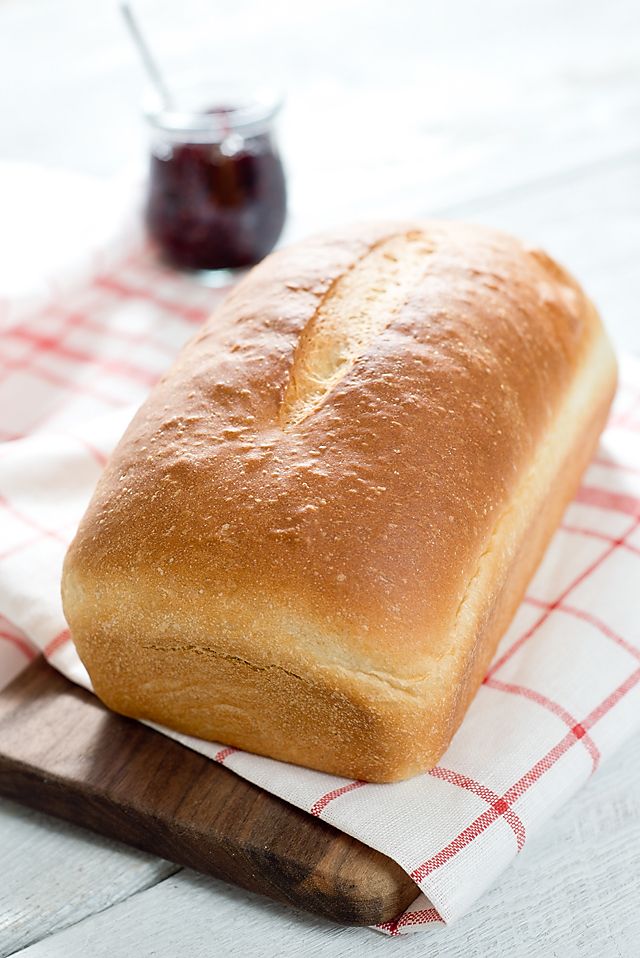 DOI:10.3390/nu12041118. Retrieved February 19, 2021
DOI:10.3390/nu12041118. Retrieved February 19, 2021 - Ram, H., Rashid, A., Zhang, W. et al. Biofortification of wheat, rice and common bean by applying foliar zinc fertilizer along with pesticides in seven countries. Plant Soil 403, 389–401 (2016). DOI:10.1007/s11104-016-2815-3. Retrieved February 17, 2021
- Yılmaz, H., Cagla Ormeci Kart, M., Demircan, V. (2016). Economic analysis of pesticide use in wheat production for sustainable rural development. International Conference: Economic Science for Rural Development, 42(16), 295-302. Retrieved February 17, 2021
- U.S. Department of Agriculture. Grains. Retrieved April 4, 2021.
- Academy of Nutrition and Dietetics. (2018). Kids and portion control. Retrieved April 4, 2021.
- Academy of Nutrition and Dietetics. (2020). What and how much should my preschooler be eating? Retrieved April 4, 2021.
- Food Allergy Research & Education. Wheat Allergy. Retrieved June 7, 2020
- Food Allergy Research & Education.
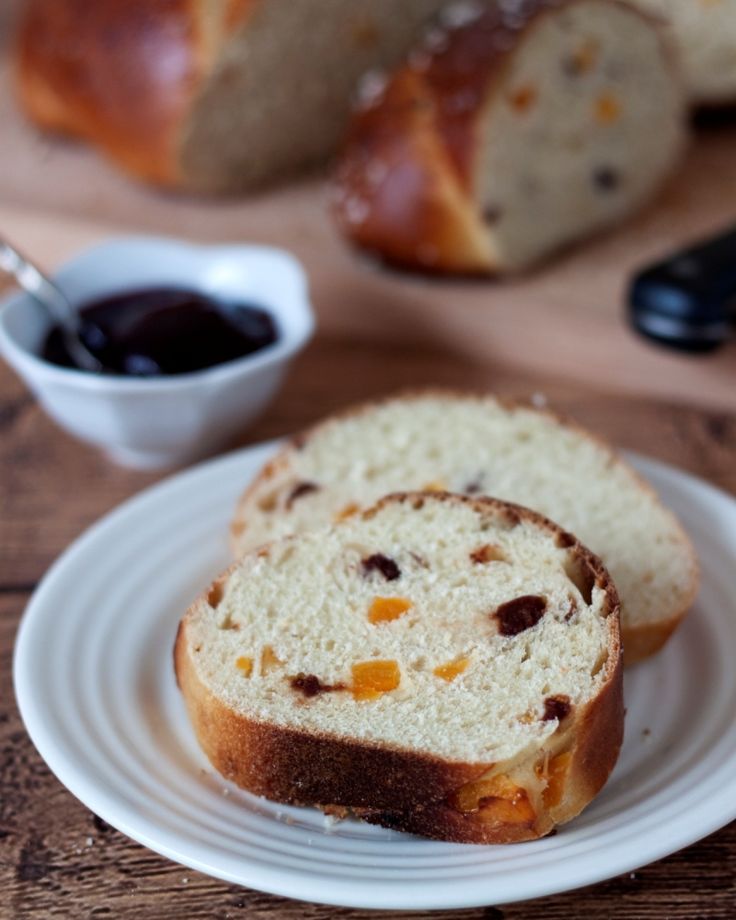 Wheat Allergy. Retrieved June 7, 2020
Wheat Allergy. Retrieved June 7, 2020 - Kashyap, R. R., & Kashyap, R. S. (2015). Oral Allergy Syndrome: An Update for Stomatologists. Journal of allergy, 2015, 543928. DOI:10.1155/2015/543928. Retrieved February 17, 2021
- Feldweg AM. Food-Dependent, Exercise-Induced Anaphylaxis: Diagnosis and Management in the Outpatient Setting. J Allergy Clin Immunol Pract. 2017 Mar-Apr;5(2):283-288. doi: 10.1016/j.jaip.2016.11.022. PMID: 28283153.
- Food Allergy Research & Education. Wheat Allergy. Retrieved June 7, 2020
- American College of Allergy, Asthma & Immunology. Wheat Allergy. Retrieved February 17, 2021
- Celiac Disease Foundation. What is Celiac Disease? Retrieved February 17, 2021
- Massachusetts General Hospital. Center for Celiac Research: Celiac Disease FAQ. Retrieved February 17, 2021
- Elli, L., Branchi, F., Tomba, C., Villalta, D., Norsa, L., et al. (2015). Diagnosis of gluten related disorders: Celiac disease, wheat allergy and non-celiac gluten sensitivity.
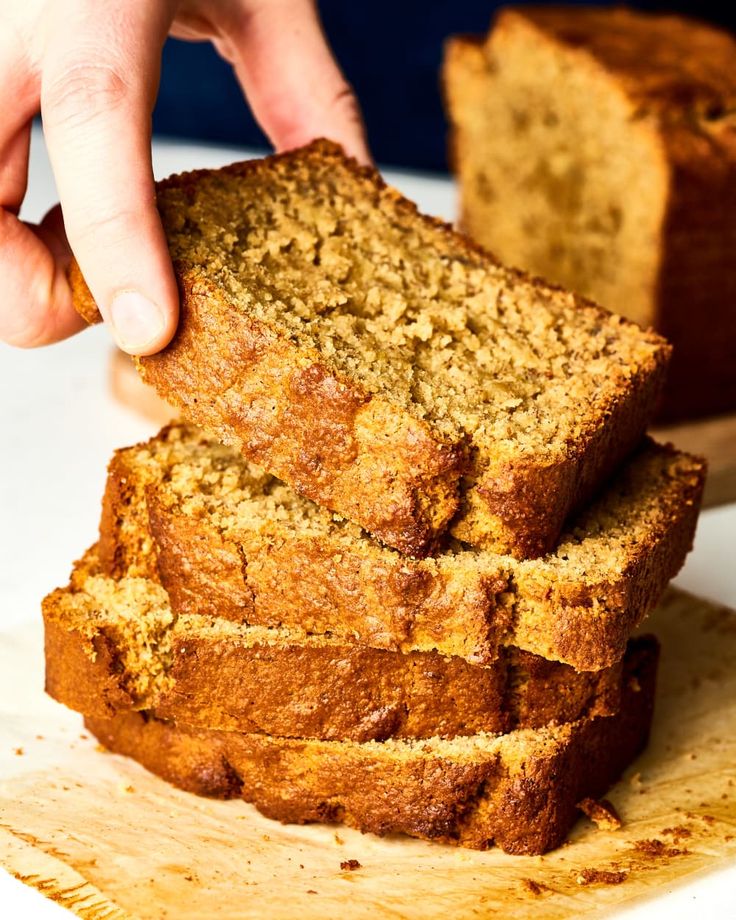 World journal of gastroenterology, 21(23), 7110–7119. DOI:10.3748/wjg.v21.i23.7110. Retrieved February 17, 2021
World journal of gastroenterology, 21(23), 7110–7119. DOI:10.3748/wjg.v21.i23.7110. Retrieved February 17, 2021
Bread in the child's diet. When and what kind of bread can be given to children
Bread in the child's diet. When and what kind of bread can be given to childrenThe value of this product in the children's diet is not only that bread is a source of carbohydrates, proteins, vitamin B and a group of important trace elements. Bread is also important for a child to improve their chewing skills. Like everything new, he is extremely interested in this process, and therefore there are practically no kids indifferent to crackers.
Dry initial milk formula adapted by Valio Baby 1 NutriValio for feeding children from birth to 6 months More
Dry milk drink "Baby milk" Valio Baby 3 NutriValio for feeding children over 12 months More
Follow-up dry milk formula adapted by Valio Baby 2 NutriValio for feeding children from 6 to 12 months Read more
The main question that worries mothers is when can small children be given bread? Pediatricians have no disagreements here. You can offer your child a white bread cracker as early as 7–8 months. Just give us ordinary white bread in a brick, not a long loaf - as a rule, it contains a lot of margarine. Be careful that there are no bran and nuts in the bread (and even their traces, this information is usually written on the labels). Bran may appear on the baby's menu later and only with the approval of the pediatrician, and nuts are a very allergenic product, and you will not always be able to find out which traces of nuts were in the bread.
You can offer your child a white bread cracker as early as 7–8 months. Just give us ordinary white bread in a brick, not a long loaf - as a rule, it contains a lot of margarine. Be careful that there are no bran and nuts in the bread (and even their traces, this information is usually written on the labels). Bran may appear on the baby's menu later and only with the approval of the pediatrician, and nuts are a very allergenic product, and you will not always be able to find out which traces of nuts were in the bread.
Up to 3 years old, babies should not be given rye bread. It contains a lot of gluten and oligosaccharides.
Such bread is very useful for adults, but it is still extremely difficult for a child's body (oligosaccharides are not digested, since babies do not yet produce the enzymes necessary for this).
Black bread can cause fermentation, as well as seriously disrupt the delicate gastrointestinal tract. Avoid freshly baked bread as well. However, for parents, its benefits are very doubtful. Baking can also appear in the child's diet only after he reaches the age of three. Let's have very little of it. You can't argue, the sweet bun is very tasty, but its biological value is low, but the calorie content is off scale.
However, for parents, its benefits are very doubtful. Baking can also appear in the child's diet only after he reaches the age of three. Let's have very little of it. You can't argue, the sweet bun is very tasty, but its biological value is low, but the calorie content is off scale.
When buying bread for a child, always choose the product in the package. Give preference to a reliable manufacturer and be sure to check the expiration date. By default, bread is good for 24-48 hours. In no case do not buy a long-term storage product, it may contain vegetable fats, flavor enhancers and stabilizers, and even ethyl alcohol.
Almost all small children love bread. Be vigilant - this should not be the only food that the baby eats per day. A child can happily chew on a crust all day and refuse soup and other dishes - hearty bread, it perfectly dulls the feeling of hunger.
Many experts advise giving children bread after the main meal. Think of it as a dessert for a baby.
And, of course, control the amount of bread in the children's menu. This is important for the formation of eating habits and the prevention of overweight. Start giving bread literally 5 grams, by 1 year you can double the portion, from a year to a year and a half you can already give a piece (20-25 grams), from 1.5 to 2 years - two pieces, after two years - up to three pieces of bread.
#PROMO_BLOCK#
3.39 28
FoodShare:
Author: Reetta Tikanmäki
Palm oil in baby food
Infant milk formulas are made from cow's milk.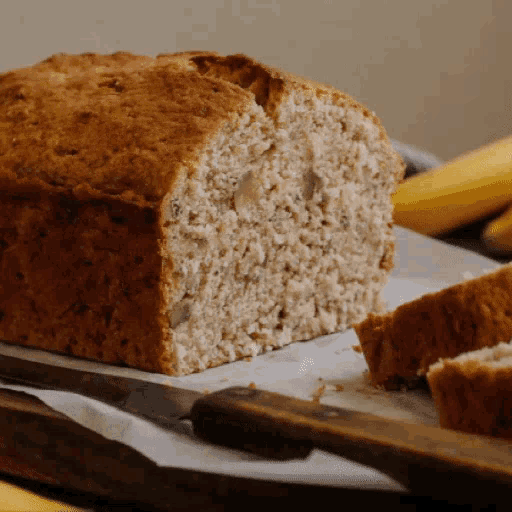 However, in terms of fat composition, it differs significantly from that of the mother.
However, in terms of fat composition, it differs significantly from that of the mother.
Read
Author: Ivargizova Oksana
How to choose milk formula for a baby
Breast milk is the best food for a newborn baby. It contains all the necessary nutritional components that fully meet the needs of the child and are necessary for his healthy and harmonious development.
Read
Show all
We want to make our site more convenient for you, so we collect analytical data about your visit using cookies. By continuing to use the site, you agree to this. For more information about the collection and processing of data, see the Policy regarding the processing of personal data.
Password recovery
To recover your password, enter your e-mail, which you specified during registration. We will send you a message with further instructions to this e-mail
We will send you a message with further instructions to this e-mail
Thank you for contacting us!
A letter with information to reset your password
has been sent to your mail
Back to the site
YOUR CITY -
?
Yes Change
We want to make our site more convenient for you, so we collect analytical data about your visit using cookies. By continuing to use the site, you agree to this. For more information about the collection and processing of data, see the Policy regarding the processing of personal data.
SELECT CITY
At what age can you give bread to a child
Bread regularly appears on the table of most families and is among the most popular products. Therefore, after the birth of a baby and the start of the introduction of complementary foods, every mother has questions about including it in the children's menu - when can it be given, how much to offer the baby and what kind of bread is most useful for babies?
How to bake
The simplest bread recipe includes flour, water, yeast and salt.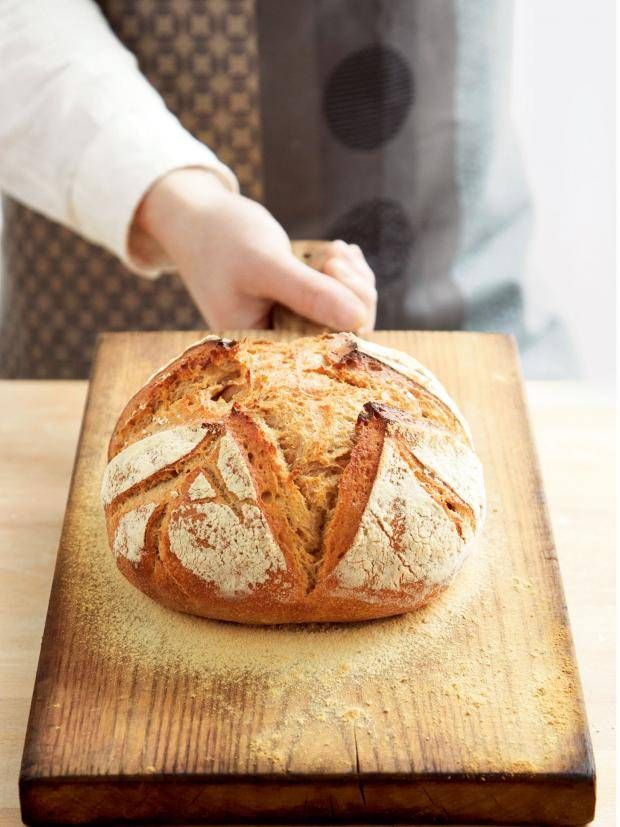 It can be expanded to include vegetable oil, milk, eggs, sugar, whole grains, butter, seeds, and many other ingredients.
It can be expanded to include vegetable oil, milk, eggs, sugar, whole grains, butter, seeds, and many other ingredients.
Flour is used not only wheat, but also rye, corn, buckwheat and others. Also, the modern food industry produces bread, in which the content of certain components is reduced, for example, loaves with less starch, salt or protein.
Many kids are interested in how bread is made and they enthusiastically listen to their mother's story about its baking. Pictures or videos help children learn the details about making bread. For example, kids can watch the cartoon from the series "Secret to the whole world", presented below, in which a puppet wolf takes a tour of the factory, where tons of bread are baked daily.
Benefit
- It has a balanced nutrient composition. It contains healthy vegetable proteins as well as complex carbohydrates.
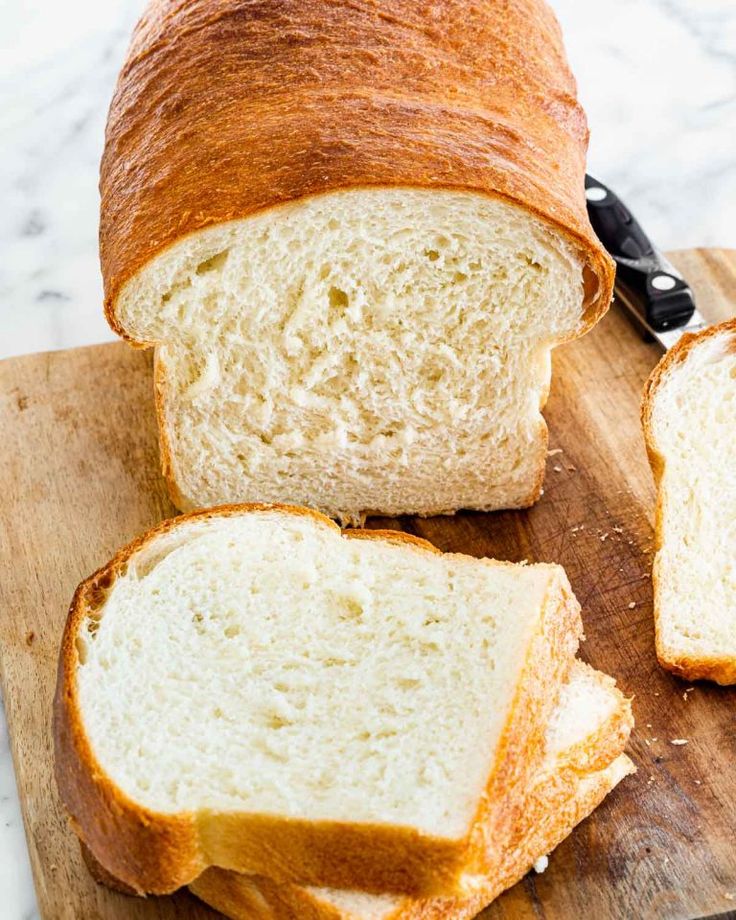 It also acts as a source of many vitamins (B1, PP, B3, E, B6 and others) and trace elements (Mg, K, Mn, Fe, Ca, P, etc.).
It also acts as a source of many vitamins (B1, PP, B3, E, B6 and others) and trace elements (Mg, K, Mn, Fe, Ca, P, etc.). - Rye bread contains a lot of dietary fiber and a high content of B vitamins.
- Pleasant smell activates the production of digestive juices , so that food is digested faster.
- Bread containing whole grains, bran, seaweed, linseed, sesame and other additives enriches the diet with minerals and fiber.
Possible harm
- Due to the content of oligosaccharides, the enzymes for digestion of which are absent in young children, its absorption in the first years of life is difficult , therefore, Borodino bread should not be included in the diet of a child up to 1-1.5 years.
- A product baked from wheat flour is a source of gluten, to which some children are allergic. Also, an allergic reaction is possible to bakery products containing eggs.
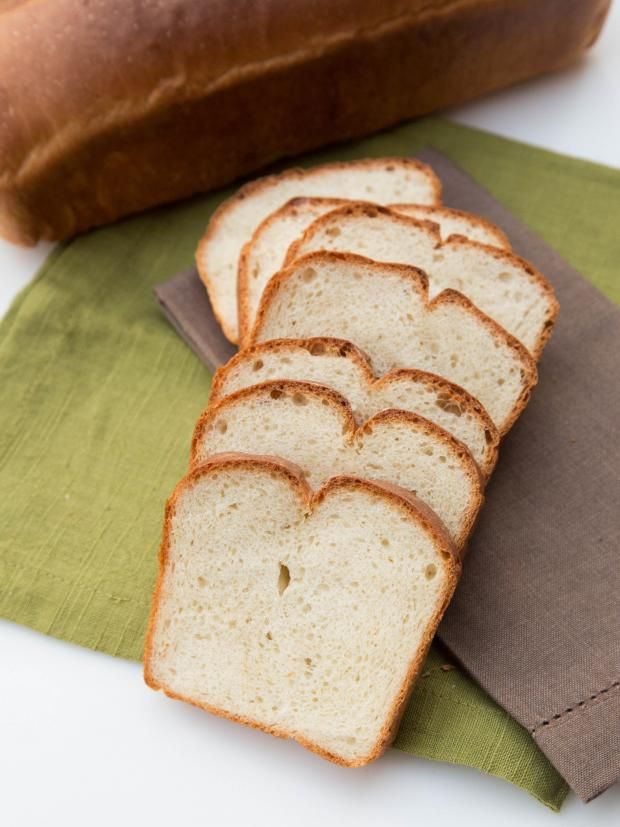
- A bun baked from white flour with the addition of butter and sugar brings little benefit to the child's body, because buns lose vitamins during production. In addition, such pastries are high in calories. It is not advised to include in the menu of children under 2-3 years of age.
- Freshly baked, it is not recommended for children under 3 years of age due to its high gluten content.
- Giving bread to toddlers who do not chew well can be dangerous ( the baby will not chew it well and may choke ).
- The child may snack on them, which will reduce his appetite at the time of the main meal. Because of this, children may refuse other healthy foods, such as vegetables.
- Excess consumption of black bread can interfere with iron absorption and cause anemia.
How many months to introduce complementary foods?
From 7 months of age kids can try bread-like products - croutons and baby biscuits. White bread appears in the diet of infants with any type of feeding at 8 months in the amount of 3-5 grams per day. The same portion is offered to a 9-month-old child, and from the 10th month of to a year, the wheat product begins to be given at 10 g per day.
White bread appears in the diet of infants with any type of feeding at 8 months in the amount of 3-5 grams per day. The same portion is offered to a 9-month-old child, and from the 10th month of to a year, the wheat product begins to be given at 10 g per day.
From the year the amount of white bread in the child's diet is gradually increased. If, after including it in the children's menu, the little one has colic, bloating, restless behavior or stool disorders, you should consult your doctor. The doctor will help to find out the cause and prevent problems with the further addition of bakery products to the baby's diet.
Inclusion in the children's menu of black bread and bakery products with various additives, for example, with bran, pediatricians, including Dr. Komarovsky, do not recommend up to 1.5-2 years of age. You can introduce a child to black bread at the age of 1.5 years, giving the crumbs a maximum of 10 g of this type of baking.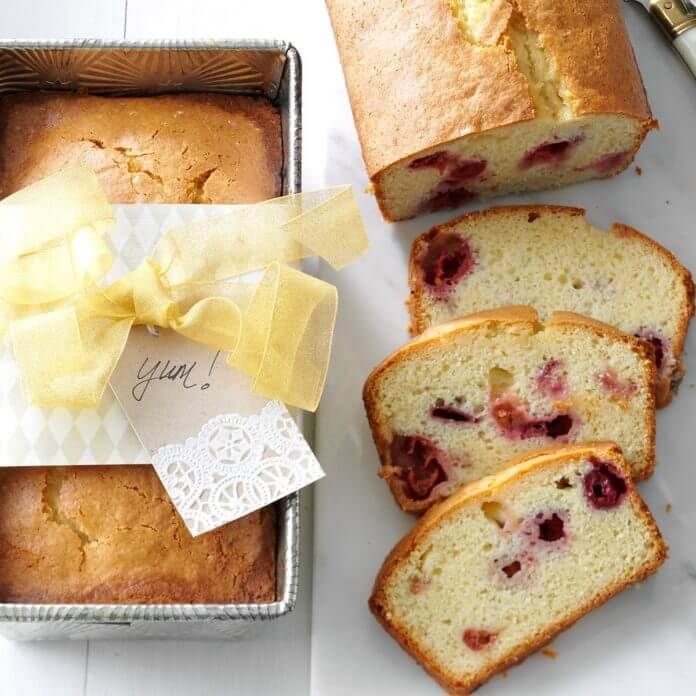
The edition of Dr. Komarovsky's program dedicated to varied baby food, see below:
Two year old give up to 100 g of bread per day - up to 70 g of wheat and about 30 g of rye . The daily portion for a child over three years old increases to 150-170 grams, including approximately 50-60 grams of rye bread. Schoolchild is given 200-300 g per day, offering black bread in the amount of 75-150 g.
Hello, Lyudmila!
Tell me, please, at what age can you start giving bakery products to a child. I already give drying to the baby, and he is happy to procrastinate them. I always stay close and make sure not to bite off a piece.
What about bread? At what age can you give bread to a child?
Good question. It is often asked to me, and today in this article we will analyze everything in detail.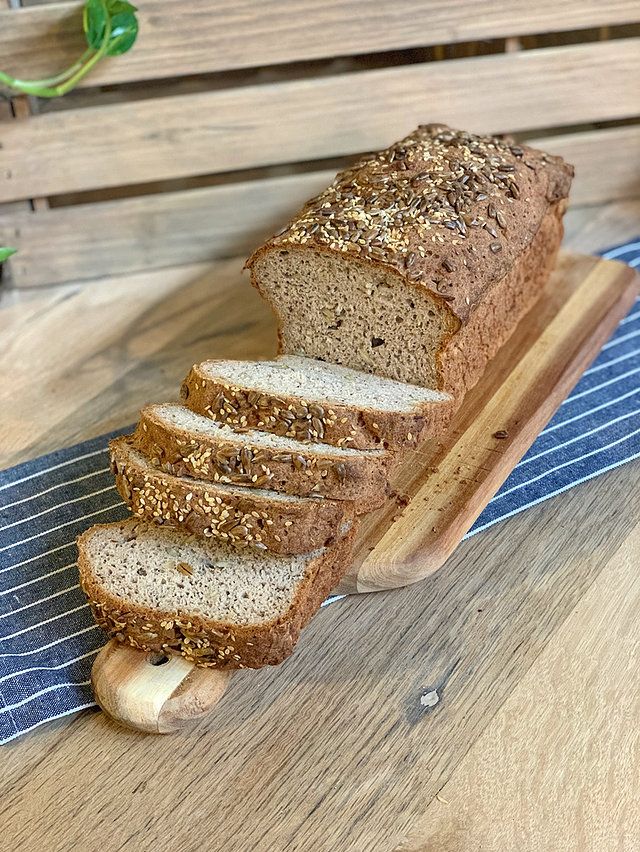
Benefits and harms of bread for a child
Bread contains a large amount of valuable nutrients needed by a small organism. It contains a lot of protein and carbohydrates, as well as B vitamins and various trace elements.
In addition, it contains vegetable fiber, which contributes to the normal functioning of the intestines, improves appetite and removes toxins.
It contains a lot of starch, which is converted into glucose, which is necessary for the full functioning of the brain.
And fragrant and tasty loaf enhances the secretion of gastric juice, stimulating appetite.
Minerals, which are in the composition, contribute to the full growth, physical and mental development, namely:
- magnesium;
- iron;
- potassium;
- phosphorus;
- calcium;
- manganese.
At what age can a child eat bread?
Bread should not be rushed, especially in the first months of complementary foods.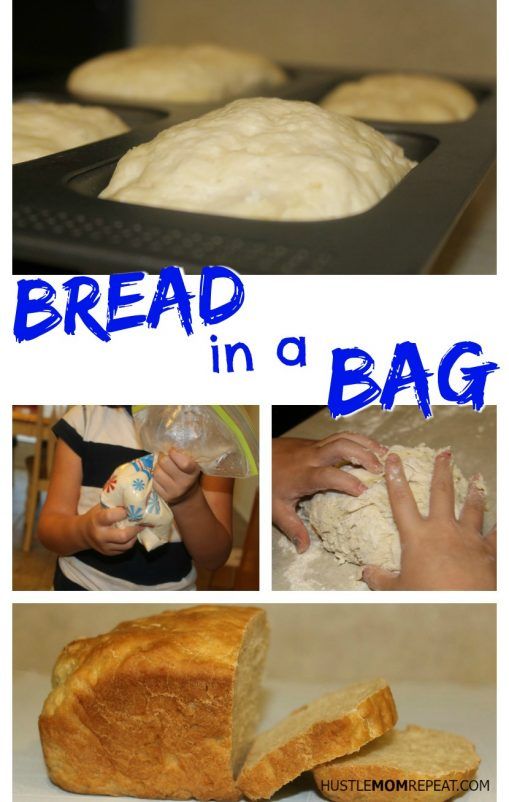 It is much more important to introduce the child to the main, basic food groups:
It is much more important to introduce the child to the main, basic food groups:
By the end of the 7th - beginning of the 8th month, you can offer the child microdoses of bread to get acquainted with the product.
A microdose is a piece the size of a grain of rice that a child can place in their own mouth and swallow safely.
Many mothers give the child to gnaw drying or dried crust of bread. Only in this case, it is imperative to be close to the child and control that he does not bite off too large a piece of soaked drying or bread. Read also the article How to teach a child to chew>>>
We analyze in detail how, when and what foods to introduce into a child’s diet on the online course The ABC of complementary foods: safe introduction of complementary foods to babies>>>
Important! Never leave a child who has not mastered the skill of chewing alone with food.
It is better for a child to give ordinary white bread in bricks, not a long loaf - there is a lot of margarine in it.
After 9 months, you can start introducing dried crackers and other baked goods into your diet.
How much bread can a child have?
When introducing bread, the amount of the product should not exceed 3 grams. Closer to the year, it is allowed to increase the portion to 20 grams.
At the age of one and a half, the child can be consumed during the main meals:
Volumes and dosages do not matter, because with the correct introduction of complementary foods, the child does not eat more portions than his body requires. Read also the article WHO Complementary Feeding Chart>>>
If a child older than a year does not eat well, you have to persuade or force him to eat another spoonful of food, see the online course Eating with pleasure: returning a healthy appetite to a child>>>
What types of bread are useful
In order for a child to benefit from bread, and not harm, you need to know what kind of product he needs and from what age a certain variety can be consumed.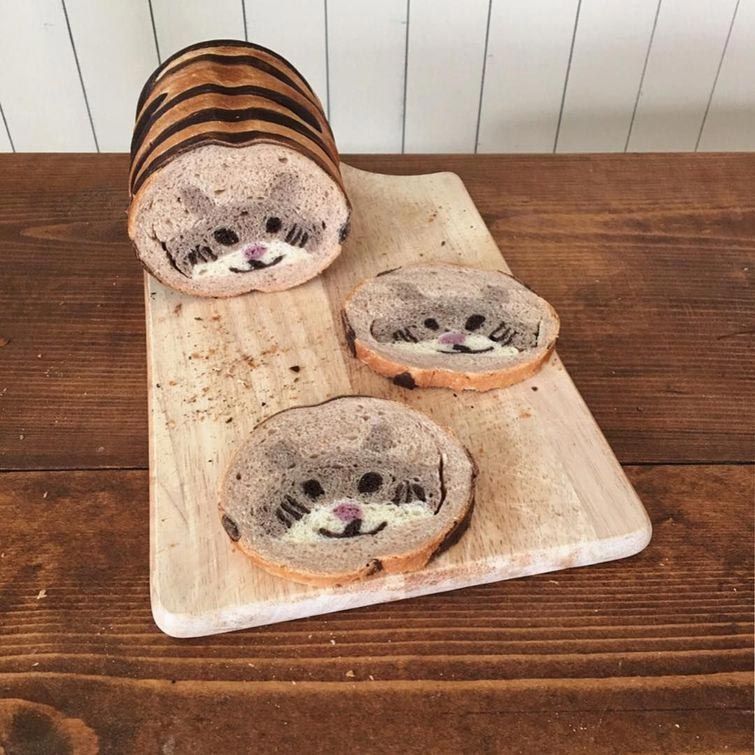
When to give rye bread to a child?
From the age of 3, you can already try to give your baby rye or bran bread.
Why from the age of 3? Rye bread contains a lot of gluten and oligosaccharides. To digest these substances, the baby does not yet have the necessary enzymes. And bran has a rough structure, which causes indigestion.
Also at this age, black bread should appear in the baby's diet, as well as made from wholemeal flour, but this should be done carefully.
Black bread causes fermentation and can seriously disrupt the delicate gastrointestinal tract.
Attention! Small children should not eat freshly baked loaf.
Be sure to observe the ratio of white and black bread in the baby's diet:
- At 8 months only bakery products made from white wheat flour.
- From a year to a year and a half, a child's diet can include 50 grams of white and 10 grams of black bread.
- From one and a half to 3 years, give 60 grams of white and 30 grams of black.

Is it possible for a 1 year old child to have rich bread?
Muffin should appear in the child's diet only after 2-3 years in a small amount. A sweet bun has a lot of calories, but there is little benefit from it.
Bread products must be free of seeds, fillings and nuts, as well as dyes and preservatives.
Do not feed your baby with a product that has a long shelf life. It contains harmful vegetable fats, flavor stabilizers and many other harmful additives.
How to choose when buying and store
When choosing a product in the store, pay attention to its quality. Good bread has the following criteria:
- correct even shape;
- no burn marks;
- the product is in the package;
- shelf life no more than 48 hours.
Store different varieties separately for several days.
The bread bin should be periodically ventilated and wiped with a weak solution of vinegar.
Can a child be allergic to bread
Since different additives are added to bakery products, they can cause allergies. The reaction manifests itself in the form of a rash, but there may also be a disorder of the stool. Read more in the article Allergy to complementary foods in infants>>>
The reaction manifests itself in the form of a rash, but there may also be a disorder of the stool. Read more in the article Allergy to complementary foods in infants>>>
This product may contain gluten, which causes allergies in many children. Complete intolerance to the product is rare.
Important! When introducing bread into your diet, be sure to watch how the child's body reacts to it.
In case of allergic symptoms, the use of the product should be limited or completely avoided. It is necessary to offer it to the baby carefully, observing the rules of complementary foods.
Introducing bread into a child's diet is not only possible, but also beneficial. The main thing is to use the allowable amount for a certain age and choose the right variety.
In this case, he will not have allergies and stool disorders, and the body will receive the maximum benefit from consumption.
It is always exciting and scary to introduce new complementary foods into the baby's diet.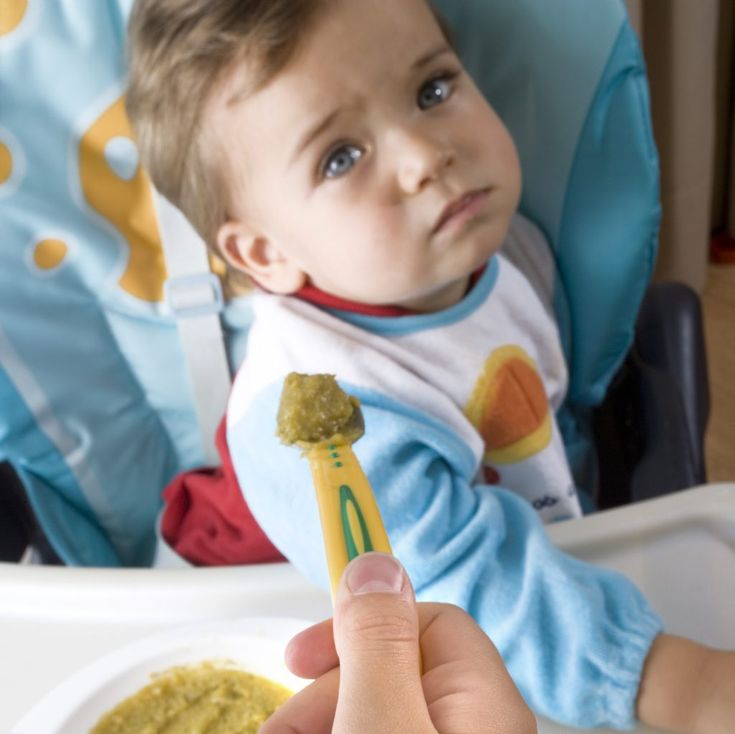 You never know how the baby will react to it. The crumbs may develop allergies, tummy ache and even a fever. Starting from 4 months, the little one can already be given to try the first fruit and vegetable purees in his life. Not all, of course, but most. Understanding when and how to introduce them into the baby's diet can be easy. All this information is contained on the baby food label. You just need to find it and read it carefully. That's just at what age you can give the baby bakery products, it is not written on the label. Young parents are beginning to think about how not to harm the still undeveloped digestive system of the baby.
You never know how the baby will react to it. The crumbs may develop allergies, tummy ache and even a fever. Starting from 4 months, the little one can already be given to try the first fruit and vegetable purees in his life. Not all, of course, but most. Understanding when and how to introduce them into the baby's diet can be easy. All this information is contained on the baby food label. You just need to find it and read it carefully. That's just at what age you can give the baby bakery products, it is not written on the label. Young parents are beginning to think about how not to harm the still undeveloped digestive system of the baby.
Different types of bread have different composition, but the most useful for young children is white bread
Ingredients for baked goods
If desired, bread can be prepared by anyone. Its recipe is simple and does not require a lot of ingredients. So, what is included in its composition:
- Flour. You won't be able to bake bread without it.
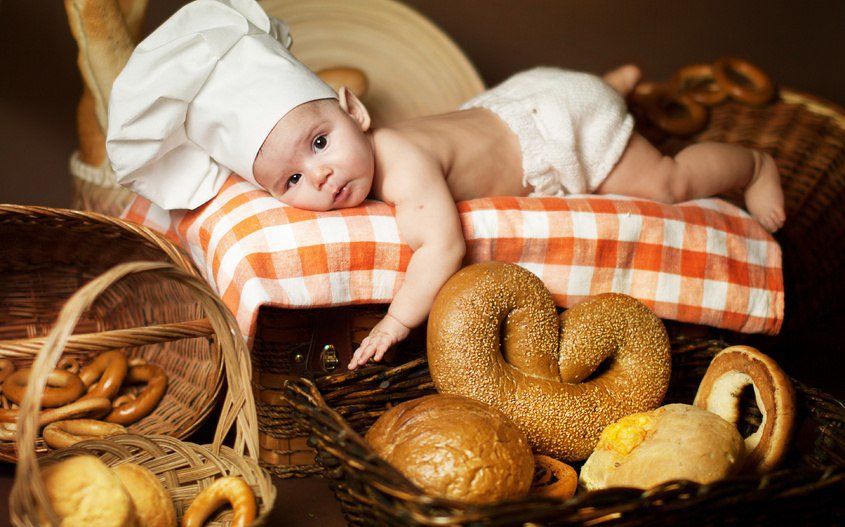 The nutritional value of flour depends on which grain it was obtained from and the degree of processing. So, wholemeal flour (of the lowest grade) contains much more useful substances than flour of the highest grade. This is due to the fact that it is less processed, which means that more valuable nutrients are stored in it. Such flour has a dark color, but the first grade is white. Its main difference from wholemeal flour is the absence of bran. Despite all the advantages of black bread over white, it is recommended that white complementary foods be introduced into the diet of infants first. This will help to avoid an allergic reaction that may occur due to bran entering the child's body.
The nutritional value of flour depends on which grain it was obtained from and the degree of processing. So, wholemeal flour (of the lowest grade) contains much more useful substances than flour of the highest grade. This is due to the fact that it is less processed, which means that more valuable nutrients are stored in it. Such flour has a dark color, but the first grade is white. Its main difference from wholemeal flour is the absence of bran. Despite all the advantages of black bread over white, it is recommended that white complementary foods be introduced into the diet of infants first. This will help to avoid an allergic reaction that may occur due to bran entering the child's body. - Table salt.
- Water.
- Yeast or sourdough.
The more complex the bread recipe, the more ingredients it contains. So, in addition to the above-mentioned bakery products, eggs, whole grains, spices, fats, milk, molasses, whey and sugar can be included in the composition of bakery products. This bread is high in calories.
This bread is high in calories.
Useful properties of bread
Bread has many useful vitamins, without which a person, and especially a child, cannot do
The fears of young mothers that the use of bread products by the baby is dangerous and that they can harm the baby's digestive system are not justified. The case is just the opposite. Bread contains so many useful and nutritious substances that it can and even should be given to a child who has not yet reached the age of one. It contains vitamins and minerals required for a growing organism. For example:
- Vitamin E found in grains has a beneficial effect on the endocrine system.
- Vitamin B1 improves the functioning of the nervous system.
- Vitamin B2 activates metabolic processes, improves the condition of the baby's skin and hair.
- Thanks to vitamin B6, unsaturated fatty acids are absorbed faster in the body of the crumbs. In addition, this vitamin has a positive effect on the functioning of the cardiovascular system and the child's brain.

In addition, the bread contains vegetable fiber (dietary fiber). It performs the following functions: increases appetite, improves bowel function, removes toxins. However, an excess of fiber in the body is no less harmful to the baby than its lack. It can cause colitis, so baked goods must be introduced into the diet carefully. You also need to carefully monitor the reaction of the baby to a particular product. A little more about the pros of bread:
- It is an excellent source of energy, as it contains a large amount of carbohydrates. For example, in rye bread there are 214 kcal per 100 grams. product, and in wheat - 233 kcal.
- In the process of chewing bread, the jaw apparatus develops in the crumbs and the oral cavity is cleansed of pathogenic microbes.
- It promotes the excretion of decay products from the baby's body.
Do not forget about the minerals that are contained in bakery products. These include magnesium, iron, phosphorus, manganese, potassium and calcium.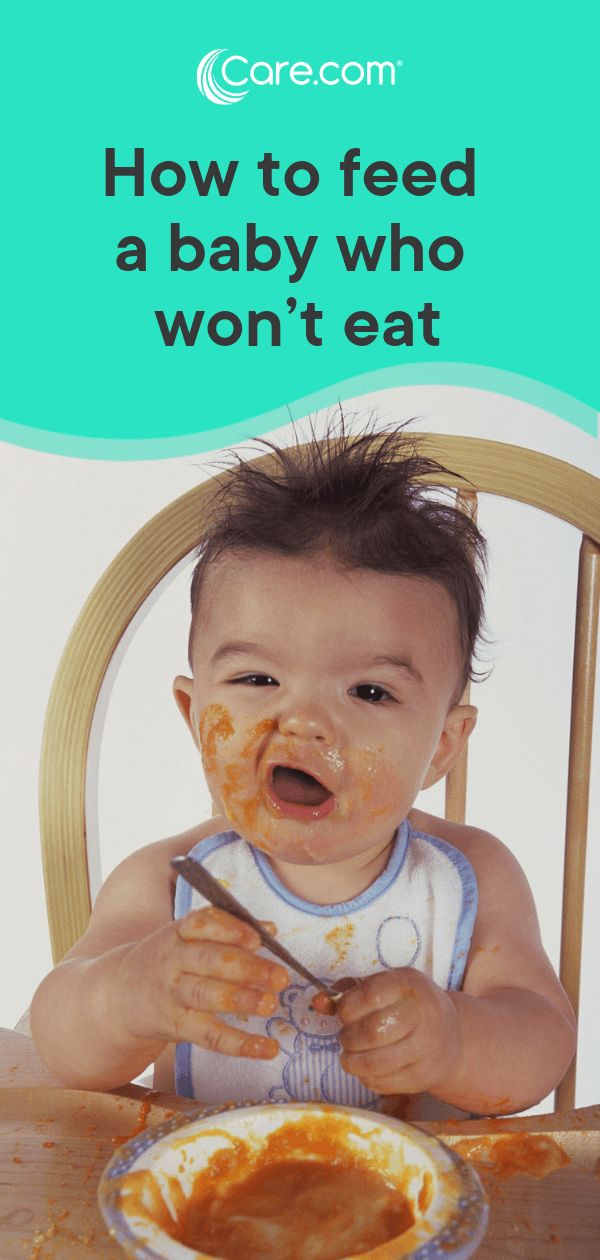 If the baby's body lacks these elements, then it will grow and develop more slowly both physically and mentally.
If the baby's body lacks these elements, then it will grow and develop more slowly both physically and mentally.
When to introduce bread products into the baby's diet?
Babies are advised to use special baby cookies that do not contain harmful additives
In order for a child to benefit from eating bread, and not indigestion, it is necessary to know which product to give, when and from what age. The first acquaintance with such complementary foods should occur no earlier than 7 months. However, it is not necessary to give the bread itself, but children's cookies or special crackers. They must not contain additives. If you are afraid that the baby will choke on crumbs, you can soften the cookies in breast milk or water. The child should really like this treat.
It is important that the cookies do not contain a lot of sugar. It is better to consult a doctor about the allowable amount, since each child is individual, and some additives can cause allergies.
What kind of bread can be consumed at a particular age?
- At 8 months old, you can already give your baby a taste of the bread itself. It must be prepared from white varieties of wheat. For the first time, bread should be introduced into complementary foods with 1-3 grams.
- At 9 months, gradually try to increase the amount so that by the age of one year the portion reaches 20 grams. Don't worry if your baby can't eat a whole serving, even a small amount of this food can have a positive effect on the body.
- By the age of 3, the amount of bakery products consumed during the day can be increased to 60-80 grams.
- At the age of 4, it is possible to introduce rye bread into the diet, as well as having bran in its composition.
Children aged 3-6 years are allowed to give wheat bread 100-120 grams per day, rye bread - 50 grams. Also, Dr. Komarovsky advises not to allow the child to consume too much confectionery. This can lead to obesity. The norm is 10-20 grams per day.
The norm is 10-20 grams per day.
What kind of bread can you be allergic to?
If your baby is allergic to bread, do not rush to remove it from the diet. You can try to make bread yourself, choosing a recipe that will be well absorbed by the child
Often, bakery products contain various additives: nuts, molasses, icing, raisins. All this can cause an allergy in the crumbs, manifested in the form of a rash. Watch your child's reaction to the product. If there are any rashes on the body or if you feel worse, be sure to tell your doctor about this problem, and it is better to stop using the “allergen”. Consider the frequently asked questions:
- What if my 9 month old is allergic to store bought bread? If the crumbs have an allergy to bread from the store, then you can bake it yourself in a bread machine. However, it should be remembered that children under the age of two should not eat freshly prepared bread. This can negatively affect their digestive system.
Bread, after its preparation, should cool and lie down for several hours. Only then can you start giving it to your child. You can check the readiness as follows: remove the bread from the oven and squeeze. If it has not returned to its previous form, then it is not ready inside, but if soon it ceased to be flattened and began to look like before compression, it is ready.
- Should I give my baby salt-free bread? No, it doesn `t need. Only a doctor can prescribe it.
- What to do if the little one suffers from constipation after 3 years? Bread with bran copes well with this problem. Its use will help improve the peristalsis of the baby's intestines.
Based on the foregoing, we can conclude that the introduction of bread into the diet for children is not only possible, but also useful, even necessary. No matter how old your child is, the main thing is to observe the amount allowed by the doctor so that the baby does not later suffer from allergies or colic.
At the age of six months, the baby is given complementary foods for the first time in the form of cereals, vegetable puree and what the delicate child's body is able to assimilate. Almost immediately, parents begin to be interested in the question: when can I give bread to the baby?
Adults perceive this product as light and dietary. Is this true for the little one? When can a child be given bread?
Benefits of bread for babies
This product is rich in B vitamins which are beneficial for the functioning of the nervous system. In addition, it contains a lot of vegetable proteins and fiber, which prevents constipation in a baby.
Important! The benefit is also expressed in the fact that the child trains his chewing skills.
It is important for an infant how to give bread to a child at 9 months or older and in what quantities.
Bread composition
Composition and benefits for the child depend on the type of wheat. There are the following types of bread :
- Wheat. This is one of the most famous varieties of this product. In its manufacture, premium flour, water, yeast and salt are used.
- Rye. In order to prepare it, you need to make a special leaven. Since the structure should not be too porous for this species, yeast is not used.
- Buckwheat. For manufacturing, the appropriate cereal is taken.
- Whole grain. Whole wheat grains are added to the flour. Of all the species, it is considered one of the most useful, but it is quite difficult for a child to digest it.
- Yeast-free. The dough rises due to hop sourdough or brine.
- From germinated grain.
The technology is as follows: wheat is germinated, then the grains are ground into a homogeneous mass, then the cooking process is similar to the creation of yeast-free bread.
The child will now eat bread
Regardless of the type, the product contains a large amount of complex carbohydrates, protein and fiber. It also contains a lot of B, PP, E vitamins. In addition, bread is rich in trace elements such as selenium, manganese, iron, phosphorus, copper, magnesium, sodium and calcium. Bread is also good for the baby's cardiovascular system.
Important! Do not give crumbs bread that contains pesticides, sweeteners, trans fats, preservatives, and those varieties that include salt.
How to choose the right bread
Bread is the most versatile food, but choosing the right kind for a baby can be a challenge due to the immaturity of a baby's digestive system.
Home or shop
No difference on average. In some cases, giving homemade bread is not as good as store-bought bread, as the former may contain elements that are difficult for digestion. It all depends on the technology of preparation. If the product is prepared in a bread maker, it is suitable for consumption.
The baby wants to eat
Black
It is not recommended to give this type of flour products to a child as it can cause fermentation and adversely affect the digestive system.
White
At what age can this type of bread be given to a child? This is the best option for babies 7-8 months old (if without a crust). But it is not recommended to feed the baby with a loaf, as it may contain a large amount of margarine. The first feeding is done carefully with careful monitoring of the reaction of the baby's body to the newly introduced product. If the child refuses to eat, you need to wait up to nine months. Bread crust is already given when the baby has normal teeth. For crumbs, regular white bread with a brick is perfect.
Two young bakery lovers
Interesting fact! Bread in cheesecloth used to be used instead of a pacifier.
Others
How to give bread to an 8-month-old baby? It is not recommended to feed the future gentleman or lady bread with bran and nuts. And do not add varieties to complementary foods, where there are traces of these products. This can lead to allergic reactions, and it will be impossible to determine which particular product caused them. After some time, when the doctor allows, you can add bran to complementary foods, but you cannot make such decisions on your own.
Baby eats bread
Do not give a child under 3 years old muffins, biscuits and other similar baked goods. Their nutritional value is very low, despite the fact that the calorie content is high.
The best option is to feed your child with special bread for children, which should contain a certain amount of nutrients. Such bread helps babies resist the negative effects of the environment and prevent some diseases.
Important! As for yeast-free bread, there is no fundamental difference for an infant compared to ordinary bread. The fact is that during the preparation of the product, yeast cells are inactivated.
How many months to introduce into the diet
When can I give bread to a baby? It is believed that ordinary white bread with a brick can be given to a child from 7 months. Because every baby develops differently, it may be too early for some. As a result, gaziki and other signals may appear, symbolizing that the child’s body cannot cope with such heavy food for him. Therefore, it is recommended to wait until 8-12 months, then you can safely give bread for complementary foods in small quantities, gradually increasing portions.
Important! Care must be taken to ensure that the child cannot choke.
What goes with
How to introduce bread into complementary foods? It is impossible to give meat, cheeses to the child along with bread. Jam and other sweets with sugar are especially prohibited, since the child's body does not yet know how to digest them.
Any other product that can be used in complementary foods may be given with bread. Dairy products, soups, cereals are especially useful for children. You can also add cow's or mother's milk to complementary foods.
Complementary bread norms
There is no clear gradation by months, since each child is individual. Heavy varieties of bread, such as black, rye, loaves, can be given to a child only from 3 years old. Until this age, white bread is allowed. As the first complementary food at 8 months, you can treat the baby with bread crumbs, which are made by yourself.
Frequency
Once a day is enough, because the child does not require a lot of food, and bread is not able to satisfy the body's need for all useful micro- and macroelements. Many children like to eat bread, if it is within reach, the baby will eat it all day, and may refuse other food.
How much
At first it is enough to give a couple of crackers or a small piece of soft bread. After a couple of weeks, you can increase the amount to twice a day. For the first time, you can crumble bread into broth, porridge or vegetable puree. Then the baby will not notice this product, but will receive all the necessary trace elements.
Possible problems
Infants are very often allergic to gluten. It is a protein found in baked goods. Very rarely, celiac disease is a complete intolerance to gluten. In the first case, this reaction disappears with age, in the second case it is a lifelong disease.
The cause of gluten intolerance is that the immune system mistakenly perceives this protein as hostile to the body. As a result, antibodies begin to be produced, and an allergic reaction appears. Babies have this problem much more often than adults because their immune systems are less familiar with different types of foods.
Allergy to gluten is expressed in the following signs:
- Appearance of small rash;
- Diarrhea;
- Severe bloating;
- Decreased appetite;
- Difficulty sleeping;
- Negative emotional state.
At the same time, the reaction to gluten manifests itself in different children at different rates. In some crumbs, allergies make themselves felt within a few hours after eating bread, and may only appear after a few weeks. One of the main criteria for gluten allergy is that, along with bread, cereals and pasta negatively affect the child.
Celiac disease is a much more severe disease than ordinary gluten intolerance. In this case, if there is bread in the diet, the baby experiences severe fatigue, swelling of the limbs, and difficulties in gaining weight. If you continue to give food with gluten to a child with celiac disease, the situation can reach a lag in physical development and anemia.
If, with an allergy to gluten, the intestines, albeit with a pathological reaction of the immune system, cope with the digestion of this type of protein, then with celiac disease, it generally refuses to do this.
In this case, it is necessary to replace the bread with buckwheat, rice and corn porridge, as well as soy dishes. Also, the baby is allowed to eat legumes, vegetables and fruits and light meat, fish.
In this case, it is forbidden to give ordinary bread to the baby, but there are special gluten-free options. They are expensive and you can do without them. Preliminary intake of gluten-free bread should be discussed with the local pediatrician.
Dr. Komarovsky says that it is possible to exclude gluten from a child's body only if there is a negative reaction of the body to it. After all, this component in itself is useful.
Thus, it is possible to feed a child with bread, but with restrictions. For a baby, this product is heavier than for an adult, so it can only be introduced into complementary foods from 7-8 months, at first you need to limit yourself to an ordinary white brick. If any pathological conditions arise with the baby, you should immediately consult a doctor.
Video
Many people cannot imagine their life without bread and other pastries. It is perhaps one of the most versatile foods. And what about adding it to the diet of babies, at what age can you give a child bread and how much?
What is bread made from?
Such a product is made from different types of flour with the addition of water and other ingredients (salt, baking powder, yeast, various seeds, nuts, and so on). It is obtained in different ways: baking, frying or steam processing. For the manufacture of the product, rye, wheat, corn, buckwheat or barley flour is most often used. So, at what age can you give your child bread?
Experts do not recommend doing this for up to a year. The reason is that it must be thoroughly chewed, which babies cannot do. They swallow large pieces and may choke. In addition, baking is not a mandatory product in the diet. Eating bread is an acquired habit, a person can do without it.
Bread can be given to small children, but not any. You should consider the composition of the product and what benefit or harm it can do to the health of the baby.
Correct Steps
So, since how many months have children been given bread? Dating a small child with this culinary product can begin after 7 months. Varieties should be gradually introduced into complementary foods:
All of these products must necessarily be designed for babies, as the manufacturers indicate on the product packaging.
In the process of introducing a new product, not only the age of the child is important, but also in what form it will be done. For example, you can give children's cookies, which dissolve in the mouth under the influence of saliva. Allergy to these products is excluded, because they do not contain gluten and are made from environmentally friendly products. In addition, when using such cookies, the baby will definitely not choke on the crumbs, which cannot be guaranteed when eating bread. But this does not mean that it is not necessary to control the process, that it cannot be allowed to completely push the product into its mouth.
When can a baby eat bread?
Are you wondering when a child can be given bread? With the advent of the first teeth, wheat crackers can be introduced into the diet, but not earlier than he is seven months old. From such complementary foods, the baby will only benefit, he will learn to bite food and scratch his gums.
Cookies, dryers, crackers, bagels are given to children only after preliminary softening in a mixture, juice, milk or kefir. Over time, these products can act as an independent dish.
Fresh bread can be given to a one year old baby with main courses:
- Meat.
- Vegetable puree.
- Soup.
Do you know what time children can be given bread, and how much? Many children love soup with the addition of small crackers or scrambled eggs with croutons. At the age of 1 year, the norm of bread consumption is 80-100 grams. In this case, the amount of white should not exceed 60 g, and black - 10–15 g.
Interesting! Our grandmothers and great-grandmothers had a tradition of offering bread to a child by cutting off the crust or wrapping the crumb in a cloth napkin. So they replaced the pacifier. In modern life, there is no such need, but some families still honor traditions and try to observe them.
Benefits of product
Bread contains carbohydrates, so it is considered the main source of energy. In addition, it contains such valuable elements as: vitamins of group B and PP, iron, potassium, magnesium, calcium, manganese and phosphorus.
When using this product, vegetable fiber enters the body, which allows normalizing the activity of the digestive tract and metabolism. But this does not mean that bread should be given to children under one year old, at this age, excess fiber can interfere with the absorption of iron and cause anemia.
Harmful baking
Dietary fiber provokes colitis and intestinal inflammation. Black rye bread contains 7% fiber, and white bread contains 3%. It is for this reason that experts advise starting acquaintance with the product only at the age of one, and not earlier. Moreover, the introduction of complementary foods does not affect this in any way.
Many manufacturers add thermo yeast and baking powder when mixing the composition. This helps to reduce the time for the “ripening” of the dough, and the second ingredient is responsible for the splendor of the finished product. After entering the child's body, thermo-yeast begins to take useful vitamins and microelements from it, using them for their own growth. Therefore, it is recommended to purchase bakery products from trusted manufacturers, but it is better to bake them yourself.
What kind of bread can be given to children?
First of all, this is bread baked from first-class wheat flour. Ideally, you should bake it yourself at home. Only in this case, you can be completely sure of the quality of the product and that it does not contain harmful impurities.
If this is not possible, and you have to buy bread in the supermarket, then you need to pay attention to its freshness and integrity. In addition, it is important that the product does not have dents or burnt spots. It is not recommended to buy loaves for a young child; it is better to give preference to the usual "brick".
At what age can a child be given bread? For babies who are not yet a year old, select only high-quality wheat products, then you can gradually introduce a rye product. Bread with bran can be tasted no earlier than two or three years, since cereals in the body of young children are poorly digested and can disrupt digestion.
Important! Babies should never be given freshly baked products! They contain a lot of gluten, which can disrupt the digestive system.
It is equally important to know how to give bread to a child. For the first feeding, the product should be softened by soaking in mother's milk or a mixture. This moment must be observed, since small children still do not have a chewing reflex, and they can choke.
How to introduce bread into your baby's diet
Many newly-made parents ask themselves the question: “At what age can you give your child bread?” You can start complementary foods after 7 months with special cookies or unsweetened crackers for babies. As for bread specifically, experts do not recommend giving it earlier than a year old, the only exception is a home-made product or bought in a trusted bakery. But the age of the child must be more than 8 months.
It is important not only at what age children are given bread, but also how it is done. The first serving is recommended to be given at the beginning of the day, so that it is possible to track the body's reaction to a new product. A piece should not be more than three grams. If the baby reacted well to the new food, then after two days the portion can be gradually increased. A child is allowed to eat 20 grams of bread per year. This product should be given for lunch in addition to soup or vegetable puree. In the process of increasing the portion, it can be added to breakfast and afternoon tea.
Child does not want to eat bread
Sometimes it happens that parents are tormented by the question of how much bread can be given to a child, and after the test, he refuses it. Or, for example, a baby happily starts eating pastries as a separate product, but does not want to combine it with the main dish. Adults in this situation begin to insist, swear, although there is nothing wrong with that.
If the child has sufficient body weight and eats up the first and second course, then you should not force him, let him eat as he likes. Food is supplemented with bread for a feeling of satiety. And from those 2-3 pieces that he is supposed to eat, you can make croutons for soup (again, if the baby does not mind it) or put it on sandwiches.
Many adults wonder how many months you can give your child bread, but you should understand that not all children love it. There is nothing wrong with the fact that he completely refuses a bakery product. He can get the necessary dose of “floury” carbohydrates from pancakes, pies and other baked goods.
First of all, parents need to understand what caused such a dislike for this product. The reason may be an allergic reaction to the gluten protein found in wheat grains.
If the reason is not health, but whims, then you need to try to draw the child's attention to food. It's very easy to make - show your imagination when serving. For example, all the little ones are enthusiastic about small sandwiches in the form of canapes. They can be built from bread crumbs fried in a toaster and cut out in the form of different shapes (stars, rhombuses, squares, triangles, etc.). From above, you can add melted cheese, spread liver pate, put crushed yolk with a spoonful of sour cream and herbs.
Child allergy to bread
Quite often, babies have an allergic reaction to bakery products. As noted above, this is due to the high content of gluten and other additives in the product. In addition, such a reaction can occur to yeast, not only in children, but also in adults.
If a child is allergic to a product bought in a store, it should be replaced with bread baked at home. In this case, you can choose absolutely any flour from the huge assortment presented on the shelves of supermarkets.
Bread allergy can manifest itself in different ways:
- Constipation or diarrhea.
- Eruptions on the skin.
- Flatulence.
- Caprices, refusal to sleep.
- Puffiness.
- Nausea and vomiting.
The rate of occurrence of reactions is individual - from several hours to several days. Often the body reacts to grains such as wheat, rye, barley and oats. Porridges from these grains also cause allergies.
Allergy relief
When the diagnosis is confirmed, bread should be completely excluded from the children's diet. Doctors prescribe medicines to relieve symptoms:
- Antihistamines (Zodak, Fenistil, Zyrtec, Suprastin).
- Bronchodilators.
- Anti-inflammatory.
- Immunostimulants.
- Drink plenty of water.
Conclusion
It is generally accepted that bread is the head of everything, but, as you can see, this is not always the case. We decided to study in detail the information about how many months you can give your child bread? They did the right thing, because there is no need to rush in this matter. New flour products should be introduced into the baby's diet gradually and with caution. And do not worry if the baby completely refuses bread, listen to him. If the baby is provided with good nutrition, then he will receive all the necessary elements anyway.
Bread in Russia has always been used not only as an addition to the main dishes, but also as an independent food product. In modern conditions, this component of the diet is one of the most significant.
For many inexperienced mothers, the question of when a child can be given bread is of great interest. After all, this product contains a lot of essential elements for human health.
Useful properties of bread for a child's body
Often, young parents tend to overinsurance in relation to bread, fearing that there will be an allergy to bread in a child. Specialists in baby nutrition rightly argue that this product is necessary for babies from the age of seven months. This is the age when you can give bread to a child with certain restrictions.
White bread is easily digested by the child's body. Its composition is somewhat depleted in useful substances compared to other varieties of the product. But it has a positive effect on the growing body of the child, especially if he has indigestion.
Black bread, as well as all varieties of cereals and bran products, contain a large amount of fiber and lactic acid bacteria. It is necessary to give bread to a child with extreme caution, observing the reaction of his body, and as for these varieties, they can be given to the baby only after a year of life.
Beneficial properties of the product for the baby's body:
- high-quality bread contains elements of iron, magnesium and vitamin E, so it is very useful for children with increased body weight;
- It is very important for the growth period that the bread contains the group of vitamins B, in particular B1. It is essential for the formation and activity of the central nervous system, as well as the launch of metabolic processes that break down carbohydrates. The lack of this vitamin manifests itself as weakness, drowsiness, irritability;
- vitamin form B2 stimulates the growth process. With its insufficiency, the condition of the baby's hair and skin, as well as mucous membranes, rapidly deteriorates;
- the structure of the product itself is important for the child, effectively cleaning the surface of the oral cavity from harmful bacteria, developing the chewing mechanism.
Bread breaks down into fibers as it passes through the alimentary tract, cleanses it of decay products and helps to remove them from the body.
In addition, tasty and fragrant bread enhances the secretion of gastric juices, stimulates appetite.
Bread as complementary foods for babies
You can benefit from bread if you know how much and when you can give this product to your child. It is also important to have a clear idea of which varieties to use. After all, for the body in the stage of formation and growth, the occurrence of disorders of the dyspeptic type is possible.
Allergy is also less common, and this entails a long break in the intake of bread products, depriving the child of important therapeutic properties.
Baby nutrition experts recommend the following algorithm for introducing bread into a baby's diet:
- feeding with bread should be started from the age of seven months, it should be given to the baby in specially designed forms, these are: baby cookies or crackers that do not contain any additives;
- It is possible to give a child bread in the usual forms from white flour when he reaches the age of 8 months, its amount in the diet should be no more than three grams.
Upon reaching the age of one year, the daily portion can be increased to 20 grams. If the newborn does not absorb this amount, there is no cause for concern. Any amount of the product will have the desired therapeutic effect;
- upon reaching the age of 2 years (and not earlier), there comes a time when it is allowed to give rye and bran products. It is possible to introduce such varieties into the nutrition scheme earlier, if recommended by a doctor. In younger children, the enzyme system may not be able to cope with the specific composition of such products;
- , salt-free varieties can be introduced into the diet only on the special recommendation of specialists, if there are objective indications for this in the form of kidney or heart failure.
Homemade bread in baby's diet
The widespread use of home bread makers has raised another question: can children safely consume their products. Answer is ambiguous:
- if a child has allergic reactions to a store-bought product, you can try to give him pastries of your own production, excluding provoking components from its composition;
- if the child is not more than 2 years old, it is strictly forbidden to give him freshly baked, and even more so hot bread.
It must be completely cooled for three hours;
- , keep in mind that home-made cooking may not be fully baked. This circumstance can be verified by the compression method. If, after removing the load, the baking easily returns to its original state: the bread is baked enough. If there is a residual deformation of the loaf, it is categorically not recommended to give it to the child, such a product is poorly digested in the child's body.
Keeping track of the above points, you can not worry about the health of the baby who has tried bread for the first time. But for some time you need to monitor his reaction to a new product.
Tips and Tricks
When starting to give bread to a child, you need to follow a few simple rules:
- The piece for the child should be slightly larger than his mouth so that he cannot place it in his mouth completely.
- To prevent a child from separating a piece, it is better to give him a piece with a crust.




